Here on the 56th latitude, the forests are on the verge of exploding into green and - I'm guessing - making the Garden of Eden look like your average city park. Spring is my favorite time of year, not just for photography but for being alive.
So let's talk about something completely different: winter! The season that has just ended. And let's start with this image...
That's what winter in a Danish forest normally looks like. Gray, bleak, and dull. And that's how this past winter started. Not that that is necessarily a problem. My philosophy is that you work with what you've got, so if gray, bleak, and dull is what you've got, you somehow make it work, which I think I did with this image.
But then something happened.
At first it was just a slight sprinkle of white, but that was enough to get me excited. To which you may say, "But isn't Denmark, like, almost at the North Pole? Don't you have snow most of the year?" And no, we don't. First of all, we are nowhere near the North Pole. When you see pictures or film from Scandinavia with snow-covered landscapes, reindeer, and log cabins, those are from way up in Sweden, Finland or Norway. Denmark is much further south in the temperate zone, plus we are a very flat land with very little elevation and therefore relatively warm.
Still, even considering our placement on the map, the snow drought we've experienced in the last 10 years is new and is probably somehow connected to climate change. When I was a child (he said with a squeeky old man's voice), snow was much more common, and even in my adulthood, there have been years when my snow shovel has been on heavy active duty. Not so anymore so even a tiny bit of snow was a welcome change from the grayness.
Fast forward 1½ months where the above snow cover, which lasted less than a day, seemed to be all we would get. It looked like it would be another typical snowless winter. Until...
That day marked the beginning of a long stretch of snow and cold that would last a month or more. Mind you, it's not like we had several feet of snow. What you see in the image is about as deep as it would get, but it was enough to turn the world white, much to my photographer self's delight (my car driver self hates snow and ice).
The image shows one of my favorite trees (you can also see a couple of pictures of it here), old and steady as life and seasons come and go around it. It was actually snowing as I was taking the picture, but for some reason I couldn't for the life of me get the snow flakes to show, no matter what shutter speed I chose.
Winter culminated a few days later after another snowfall that made it possible to capture the below pictures on a magical afternoon in my local forest. Due to not having had the opportunity to do any real snow photography the whole time that photography has been my passion, I quickly had to learn the basics about it. The number one rule is to shoot while the snow is still covering the tree branches. It makes a world of difference, but also limits your window by a lot. Another rule is, of course, to not over-expose the snow, which can be difficult to avoid, but I think I managed. Last but not least, capture the snow while it's falling. I failed that one for sure.
Winter photography doesn't just equal snow. By the middle of February most of the snow had melted, but the cold returned for another round. At first it didn't result in new snow, but instead we got a period of pretty harsh frost that turned lakes and even coastal waters to ice. I missed most of that, but did catch this interesting jigsaw puzzle of ice breaking up.
At the time of the above shot, I thought for sure that would be the last we would see of winter, but - true story - two days later, my local forest looked like this...
That picture was taken around dusk, and no, it's not black and white. This is what it looked like, revealing yet another one of winter's many faces.
However, I have saved the best for last. The below image was shot during a photo outing in the woods that, despite a bit of snow on the ground, was terribly uninspiring and - until I stumbled on the below scene - hardly yielded anything worth keeping. Then, accompanied by heavenly trumpets, this sight appeared before me and instantly made me drop to my knees... That is, in order to capture the scene from the low angle that would perfect the "door to spring", as I call it.
At the time "Door to Spring" was shot, spring was actually still 2½ months away, so the door closed again pretty quickly. Now, 2½ months later, I look back on a winter season that, I feel, for the first time since I got into photography, offered plenty of opportunities for real winter landscape photography. And real winter landscape photography, as we all know, contains plenty of that white stuff. Next winter I will most likely be back to shooting gray, dreary, snowless woodland and telling you how awesome it is, when you think of it, but you'll know that when I put my head on the pillow in the evening, I will be dreaming of snowclad trees, icy lakes, and snowflakes gently falling from the sky.
On the next episode.... Green, green leaves!
But first, a few more winter favorites:
Iceland, Faroe Islands, Vancouver Island, Bornholm... Wait a second... What did I say? Bornholm? Did I really just name Bornholm in the same sentence as those other world famous photography havens? It appears that I did, and it may be completely ridiculous, but hear me out. When I went to the island of Bornholm in the Baltic Sea in October, for the first time in my life, I, at times, felt close to what I felt during my short visit to Iceland and what I imagine others might feel when they visit the rugged coast of Vancouver Island and the vertical rock walls of Faroe Islands.
Bornholm is a 588 square kilometer island about 150 kilometers from the rest of Denmark. It is in many ways a concentrated platter of most of what landscape photography has to offer and presents a great variety in a within a very small area. You can drive from one end of the island to the other in less than an hour and on the way see rocky coastline, majestic forest, sweeping open land, sandy beaches, idyllic fishing villages, valley gorges, and of course the cream of crop, the great castle ruin of Hammershus.
It turned out we were practically next-door neighbors to the last-mentioned attraction, so that made it a natural starting point for us. Hammershus Castle Ruin is an ominous fortress complex sitting on top of a hill overlooking the Baltic Sea. It's the largest and most well-preserved ruin in Denmark and is a very impressive sight. It has lots of interesting little details, but it begs for a widescreen treatment, which is what I provided in this stitched panorama. For having been taken in relatively bland middle-of-the-day light, I couldn't be happier with the result. The clouds help, too.
However, I knew as soon as I saw it that the perfect image of Hammershus would be taken during a sunset with dramatic colors and clouds in the background. To my joy, when, after spending the afternoon in a nearby town, we returned to our vacation house around sunset, the conditions were ideal. I dropped off my wife at the house and sped back to the ruin, where - having the whole castle ground to myself - I captured the below image, which is very close to what I'd envisioned earlier in the day.
In many ways, the big, gloomy looking ruin is very uncharateristic of Bornholm. The human effect on Bornholm in general bears a lot more resemblance to the Hobbit village in Lord of the Rings than it does to Mordor. Along the coastline you will find one beautiful, idyllic town after another. One of the most acclaimed examples is the town of Gudhjem (God Home) that we visited on our second day. The light was less than ideal (if light can be gray then gray it was), which meant the town didn't show itself from its best side. (The island of Bornholm is actually nicknamed "The Sunshine Island" because it has the highest number of sunshine hours on average over the course of a year in all of Denmark.) Still, it got better while we were there and I managed to secure a nice panorama as the cloud layer was opening:
It appears as if all I did on Bornholm was shoot panoramas. That's not quite the case, but I do need to show you one more, which was taken from a location very close to the one above. I feel it's one of my best multi-image, stitched panoramas ever. Not just because of how the pieces fit together and constitute a killer composition, but because of the technical challenges it offered, including the strong backlight and the fact that I was positioned close to a 5 meter edge, falling off which would have seen me land in the backyard of the yellow house in the foreground. It was so difficult that, after shooting it during our visit to Gudhjem, I actually had to go back the next day to reshoot it, because I didn't get it right the first time. I call the image "Sun Over Gudhjem", and as any Dane can tell you, that is also the name of a culinary Bornholm specialty: an open sandwich consisting of smoked herring on rye bread topped with a raw egg yolk. I personally I like my version better.
As you drive down along the coastline between idyllic towns, you often have a good view of the rugged rock formations that make up the edge of the island in a lot of places. In a Danish context, this is pretty unique. No wonder I was extremely excited to get a close look at these mysterious shapes. I even climbed out among them and made good use of my trusty wideangle 16-35 mm lens, trying to imitate rugged rock images from more famous places like Bryce Canyon or the Oregon Coast.
The third day of our Bornholm vacation proved to be the most satisfying so far when it came to photography and adventure. The day started with us taking the short drive to an old abandoned quarry that has turned into a lake and nature area: the Opal Lake. We walked on a path that took us higher and higher above the lake. With every step that we took, the view got more beautiful, culminating near the top with this breathtaking spot that surpassed all my expectations of what Bornholm would have to offer. It looked like one of those iconic places where landscape photographers from all over the world stand in line waiting their turn to get the shot, except there was no one there but me and my wife. Note, by the way, that you can see the Hammershus Castle Ruin in the background behind the tree.
After circling the Opal Lake we drove to no less than the tallest waterfall in Denmark. And here I must admit that the comparison of Bornholm to other more famous landscape photography locations becomes a bit of a stretch. Because when it comes to shooting waterfalls, Denmark is probably the last place you want to visit. So when I say "the tallest waterfall in Denmark" we're talking a 10 meter tall trickle that no doubt leaves many visitors wondering if their leg is being pulled. Still, that doesn't mean you can't shoot good photos of it, which I think I did. And to be fair, my guidebook said it's a lot more impressive in the spring than in the fall. I guess I will have to return at a more favorable time.
Our last stop of the day was the Dueodde Beach, which is famous for its incredible fine, white sand that would rival that of much warmer beaches in the Caribbean. And while the sand was indeed fine and white, that's not what attracted me the most about the place once we arrived. The tall lighthouse towering over the beach constituted a much better focal point, and this combined with the waning golden hour light made for a perfect end of the day.
As our Bornholm visit was coming to an end, I knew there was still one place I needed to go. Near our vacation house, just below the Hammershus Castle, is an iconic rock called "The Camel Head". Again, the photography gods were with me. A colorful sunset at the exact right spot and powerful winds helped turn the drama knob to 10 on this image.
The next day I packed my camera away, and we left the island after an exciting few days. The above images are of course just a fraction of what I took. You will find a few more in the selection below. It's possible Bornholm is not about to be the new Isle of Skye on the landscape photography map, but no landscape photographer could go to Bornholm and not find it worth their time. Of that I'm certain. For my own part, I can say for sure that it won't be another 50 years before I go back to Bornholm. If I returned in 2021 it wouldn't be a moment too soon.
I'm losing track of how many times I have been out in nature taking pictures when passers-by have stopped, looked in the direction that my camera was pointing, and asked, "What are you looking at?" In most cases, it turns out that what they are actually asking is, "What rare bird have you spotted?"
To most people, a middle-aged man carrying a "real" camera (as in, not a cell phone) in nature means that he is a bird photographer. The concept of just taking a picture of the landscape, or a tree, or a creek is apparently very foreign to the average person. At least, they seem quite surprised when I explain it to them, and they quickly move on. Not interested.
And it's not that I don't see the point of bird photography. I would love to be a great bird photographer, but 1) I can't tell a seagull from an eagle, 2) I don't have the patience required, and 3) I can't afford the lenses bird photography calls for. The last point should be a dead giveaway to those who think I'm a bird photographer. How could I possibly be a bird photographer when the lens attached to my camera is a 300 mm at best? Don't people know that you need at least a 400 mm lens for that?
Now, all this doesn't mean that I haven't been known to push the release button if a bird happens to enter my focus area and that I haven't taken some fairly awesome photos featuring birds. I believe I have. And there is one bird that is an exception to everything I have just said about me and bird photography: swans. While you cannot call me a bird photographer, I would definitely categorize myself as a swan photographer. I love swans. They are some of the most beautiful and most photogenic animals on the planet. Especially the kind that you find in my neck of the woods: the mute swan. It also happens to be the national bird of Denmark, and I for one am thrilled about that.
To an actual bird photographer, swans are probably what a Toyota Corolla is to a car enthusiast. Plain, common, and boring. Not to me. They may be common, but they are anything but plain and boring. In fact, they are majestic and inspiring. The challenge in swan photography lies in catching them in the right surroundings and having them pose, or interact with each other, in an interesting way. That requires a certain amount of patience and time spent observing them.
My interest in swans, I think, comes from my wife, the American, who wasn't used to the kind of swans we have in Denmark and made me open my eyes to their beauty. I mean, I grew up here and was used to swans and, like with so many other things before photography changed how I look at just about everything, I never really gave them much thought.
Another boost to my swan fascination came with the image below. It was taken not too long after I got my first "real" camera (my Sony A33) and is probably still among the three best photos I have ever taken (which, in a way, is a little sad considering all the practice I have gotten since). Look at that composition! How the swan on the left provides perfect balance to the castle on the right, and how the swan in the center of the image looks straight into the camera. Sure, I have enhanced it and turned the "magical fairy tale" knob to 10, but I like it. And it really made me consciously seek out swans to include in my images ever since.
The next image is also several years old and is my first picture of a swan with its wings spread out. It looks like an angel. Now, if you live next to swans and see swans every day, seeing them with their wings spread out like that may not be such a rare occurrence. But while I see swans quite often - probably once or twice a week - the times I have seen them in the last five years, with their wings spread out like that, can be counted on one hand. And catching them like that from the right angle and distance is even rarer. So it's something I'm always hoping will happen when I head to a place with swans, and it almost never does.
One of the things that make swans so special is their monogamy. They stick to the same partner for life and raise a new brood of cygnets every year. On a few occasions, my wife and I have followed a swan couple through a season and seen how they have built their nest, laid on their eggs, and taken their tiny new cygnets for a swim. And we have seen the cygnets grow and finally replace their gray ugly duckling plumage with beautiful white feathers. This can also be a heartbreaking experience as sometimes the swan couple will start out with six cygnets and then lose them one by one to predatory fish or birds until only a couple remain. In the below picture, a family of swans (and a friendly duck) is chilling in a local creek under the moonlight. All right, I admit, the full moon has been added, but the moon really was out that night, although not quite in such a favorable position.
Swans do other things than just be beautiful and majestic. They can be some nasty birds and apparently very territorial. One afternoon I was walking along a lake when the below scene played out. One particularly angry swan was busy keeping his part of the lake free from other swans. It's extremely dramatic when big birds like that get in each other's throats, and you really don't want to make a swan cross. This was shot with a cell phone and turned out very well for me, but at the expense of the poor couple that had ventured into the angry swan's territory. Or maybe they were the bad guys who had ventured into the angry swan's territory and got what they deserved. Who knows?
The next image is from the same lake and may even be one of the same swans, but a more common situation. There is nothing as serene and beautiful as a swan quietly drifting in and out between tufts of grass and waterweed during a sunset. They are like strange extra-terrestrial beings gracing our world with their other-worldly presence.
Standing close to a swan, you wouldn't think that their size would allow them to be particularly good flyers. But as the perfect beings that they are, flying is of course not a problem. In fact, standing underneath a flock of swans as they pass over you is a magnificent experience. You hear them before you see them. Whoosh, whoosh, whoosh. The sound of their big wings is just one of their many majestic characteristics that leave you in awe and make you look up. If you are really lucky, as I was while taking the below picture, you are carrying your camera, the camera has a suitable lens mounted, and the shutter is set to a sufficiently fast speed. That rarely happens to me since my camera is usually in landscape photography mode, but in this case, everything aligned and I got one of my few sharp pictures of flying swans.
 Last but not least: the swan heart image. I had been chasing this photo for almost as long as I have been chasing swans. Inspired by the town arms of the city that I work in, I wanted so badly to photograph two swans forming a heart with their long, beautiful necks. I had been close many times where I would see a swan couple drifting toward each other, only to break off at the last second or stick their necks into the water for food just at the crucial moment (I can't count how many pictures I have of swans with their heads in the water).
Last but not least: the swan heart image. I had been chasing this photo for almost as long as I have been chasing swans. Inspired by the town arms of the city that I work in, I wanted so badly to photograph two swans forming a heart with their long, beautiful necks. I had been close many times where I would see a swan couple drifting toward each other, only to break off at the last second or stick their necks into the water for food just at the crucial moment (I can't count how many pictures I have of swans with their heads in the water).
And then, finally this year, on Valentine's Day no less, this happened. It was a magical moment. The swan on the left had just landed on the water after having been out flying for a while. My prejudice about gender roles tells me that it was the male. The other swan - the female - saw him land, and they immediately headed towards each other and met in this, not quite perfect, heart shape in the middle of the lake. They spent the next few seconds almost wrapping their necks around each other in a loving embrace. I was absolutely thrilled.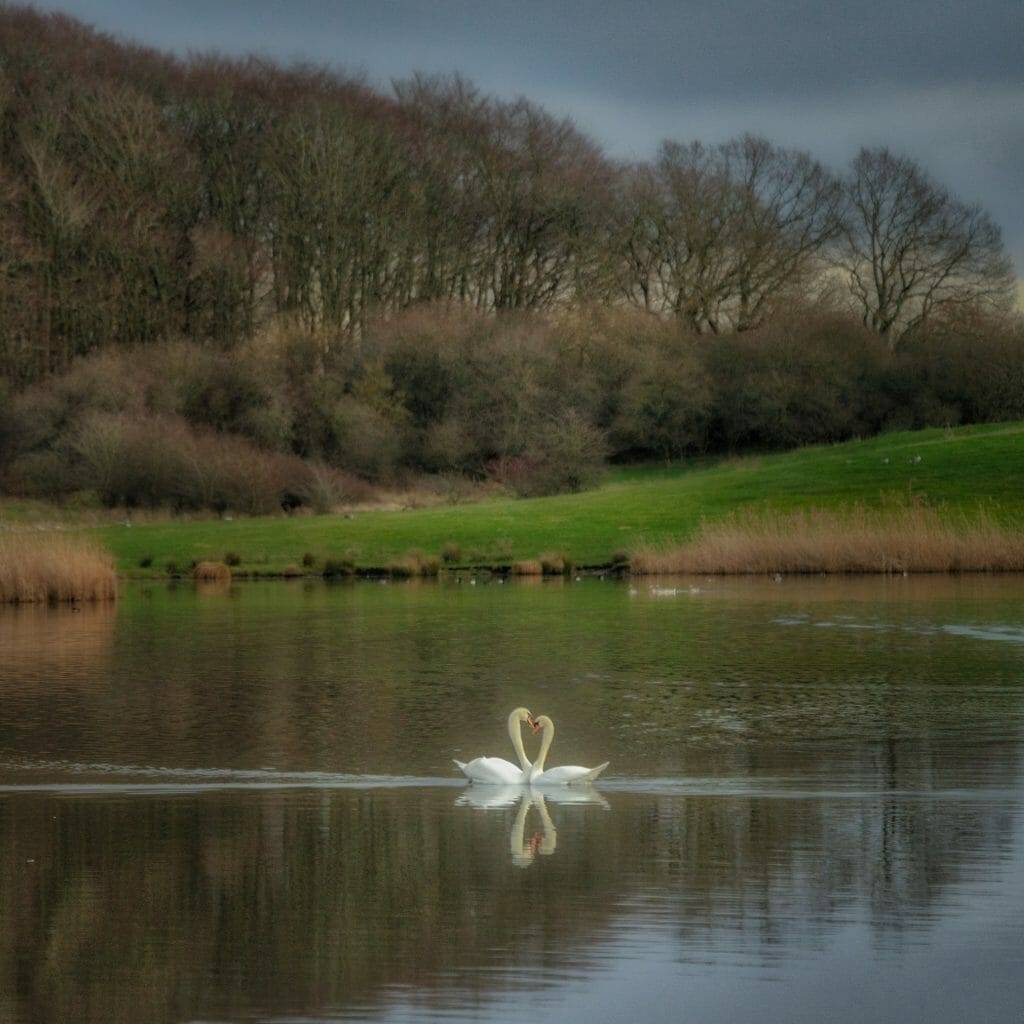
I have tons more swan pictures in my collection, but these are some of the highlights. Swans are a subject I never get tired of, and I find it almost impossible to walk past a swan without taking its picture. Other birds may be rarer or more interesting in many ways, but none are as beautiful and photogenic in all their various poses and moods.
One of the most common pieces of advice you come across from all the landscape photography gurus out there on the interwebs is that you should go about your photography in a slow and deliberate manner. Quality over quantity. They will tell you that if they take a couple of keepers a month, they are more than happy! Sometimes when they are out on a photo outing, they never even get their camera out of the bag because they "didn't see any compositions".
Part of me feel that they are probably right. I feel that I should be more like them - cool and composed - and every time I go outside with my camera, I tell myself to not take so many damn pictures, and that the ones I do take should be not good, but GREAT. I often stick to that promise - for about 2o minutes. Then I get excited. Being outside in nature excites me and overwhelms me, whether it's in my local forest or in the Canadian Rockies. I can't help it. I start to see compositions everywhere. I frantically point my camera in all directions to capture everything. I take the same picture five times with slightly different settings for fear of screwing it up.
It gets so bad that I can hardly even quit and go home. I may fold up my tripod, put my camera in my backpack, and start heading home... but two minutes later I unpack it all again, because I have seen a ray of sunlight on a branch that I'm sure can turn into the best image I've ever taken (it usually can't). This may repeat 5-6 times before - thirsty, starving, shoes wet, legs sore, and with 200+ new images on my SD card - I finally make it home. I guess you can call it FOMAS - Fear of Missing a Shot. I'm so afraid that all that beauty around me will go away, or that I will never get quite the same light again, or that I won't make it back to that exact spot at all. Often - especially when you go abroad or other parts of the country - it's more than just a fear or a feeling. It's very likely that you won't get another chance at that spot again - ever. The thought, to me, is devastating. So all I can do is keep shooting and keep shooting until every last leaf has been documented from every possible angle. If that will forever make me uncool and excluded from the landscape photography elite, so be it. Not that I had any hope of reaching it, anyway.
Now, you would think that the images I take while I'm still calm and composed turn out better than the images I take when I'm frantic. That would certainly teach me that I need to stay calm. But that's not the case. There is no pattern. In fact, if anything, it's the other way round. Often the images I take in a state of panic towards the end of my shoot are among the best of the day. The below shots are all examples of that.
The other night I got on my bike and rode deep into the forest to do some shooting at an enclosure named Ulvedalen. Ulvedalen translates to Wolf Valley, which sounds dramatic, but there really are no wolves. I don't know if there ever were. In return, there are foxes... or rather, their gloves. Foxgloves. The most magical clearings full of purple and white foxgloves. This was absolutely delightful for a photographer. I unfolded my tripod and got to work, thinking these images would be stellar.
They were not.
This is what one of the better images looked like straight out of the camera:
Now, there's nothing unusual about a RAW image looking less than amazing without at least a few enhancements, but this? What a horrendous mess! Looks like someone sprayed youghurt on the camera lens.
I was not pleased and almost marked it "Rejected". This was nothing like I remembered the scene. Where was the magic that I had felt when I was standing there? The whole scene had been so spellbinding that even the risk of having to ride my bike home through a pitch dark, unknown forest hadn't been enough for me to quit shooting. And now it looked like it had all been for nothing. Not even my usual arsenal of post-processing tricks did anything to improve things. I needed to completely rethink my editing in order to save this disaster.
Well, the first thing the image needed was a good cropping. The center of the image actually hid a pretty good composition, with the curved leading line of foxgloves disappearing into the background. In return, all the dead branches that, on the scene, I'd thought constituted a wonderful foreground had to go. Not so with the tree stub on the right and the thick branches coming out of the ground like some creepy forest monster. Those work really well as a contrast to the pretty flowers.
Thinking back on the scene, I remembered it as being much darker and with the foxgloves drawing all the attention like little, colorful lanterns. That's what I needed to recreate. The background behind the trees, in particular, needed to be all but eliminated with some serious darkening. In fact, everything in between the foxgloves needed to be darker and much more contrasty to the bright foxgloves. Plenty of Orton effect in Luminar and darkening brushes in Lightroom were among the tools I used to ensure that. The foxgloves themselves, which I remembered as being very purple and beautiful, and not the rather pale shade of the RAW image, also needed lots of work. I not only saturated them, but also brightened them - to make them seem almost glowing - with a tool I hadn't used much before: Color Efex Pro, which is part of the old Nik tools collection.
Finally, in order to make the image less messy, I had to remove several stray foxgloves here and there. Same thing with a few branches that were working against the general front-to-back direction of the image. This is the final result:
Phew... it's been a long time since I worked this hard on one image, but I really wanted a reminder of that beautiful evening. And I think I managed that quite well. It's quickly becoming one of my favorite shots of the month of June. For me it's a great example of the difference between what the camera sees and records and what your brain remembers.
The above image may not be how it actually looked and what was captured by the camera lens, but, by God, it is much closer to what I felt while standing there. And to me, that counts above everything else. So let this also be an illustration of 1) how I do not have any ethics when it comes to how much you are "allowed" to change an image in order to make it look the way you want it to - none.- and 2) apparently I do not have the photographic skills to make an image look right coming out of the camera. I rely a lot on my post-processing skills.
Do I have a problem with that? No. Does that make me less of an artist? Some would say yes. I choose to say no. (Not that I necessarily am one to begin with, but that's another discussion.)
Remember this image?
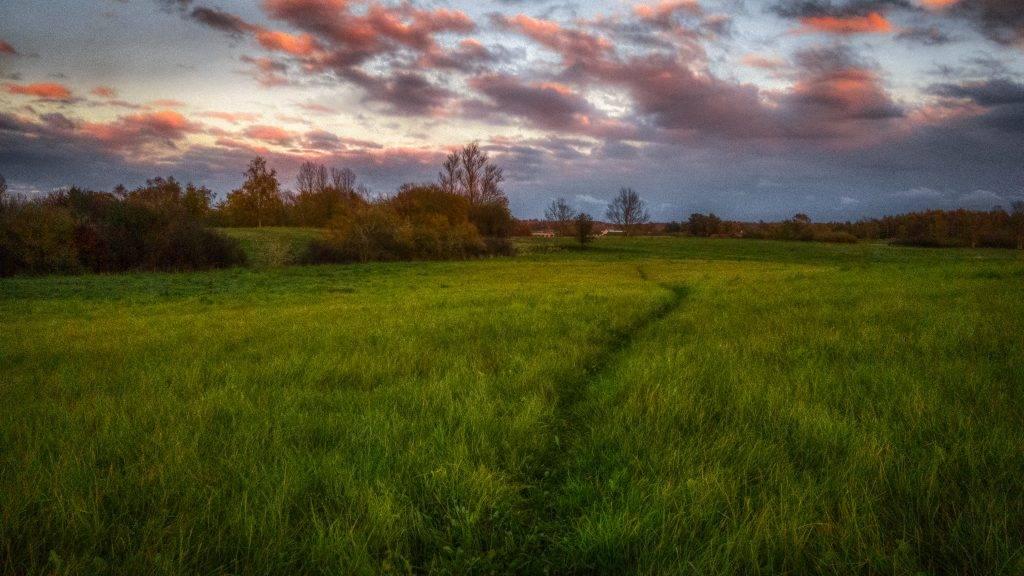
Probably not, but I posted it in the fall after roaming one of my favorite local areas, a piece of beautiful open land with tall grass, scattered trees, bushes and ponds. I have seen rabbits there, and herons. I have walked it in a foot of mud and snow and when the ground split in zig-zag cracks due to drought.
That's all over now. Today it looks like this:
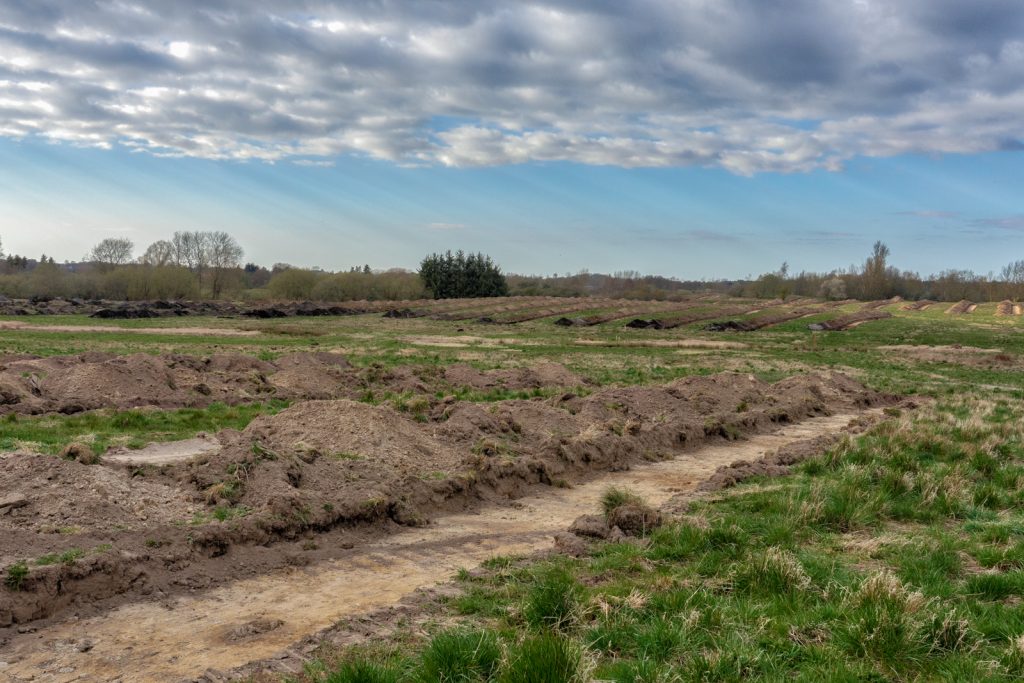
The land is now torn apart by hundreds of dirt piles and ditches like these. Progress is coming. In a year's time this will be a new part of the city, a new residential area for families with children. The rabbits and herons will be displaced and die. The rare piece of open, non-cultivated land will be but a memory.
I just realized all this the other day as I happily walked out there to see if I could put a new spin on this familiar territory with my camera. Sure, I'd seen that they were building a few houses near the road, but I never knew they were about to cover the entire 10 hectares in pavement, bricks, and hedges.
The sight of the destruction of this beautiful area almost made me nauseous. But it wasn't long before this new realization turned into an opportunity. Making my way across and around the newly dug ditches had led me close to the old farm house that struts in the middle of the area. I had always steered in a long circle around the farm house as I didn't want to get yelled at by whoever inhabited the place. Despite the lack of fences and crops, the land I was walking on may very well have been theirs.
But now, having ended up almost in their backyard, something seemed off about the place. I saw broken windows. I saw weeds everywhere. I saw junk randomly tossed on the ground. Holy cow, the the whole thing was abandoned!
Now, if you are not a photographer yourself, you don't know that the word "abandoned" is sweet music in any photographer's ears. Few things are as photogenic as abandoned locations that have been taken over by nature. There is just something about the contrast between human activity and the unrelenting nature that makes for good images.
Fearing a wrecking crew might show up at any minute to level the house, I unfolded my tripod and got to work. This could very well be my only chance to document the old buildings and the soul whose presence I could sense so clearly.
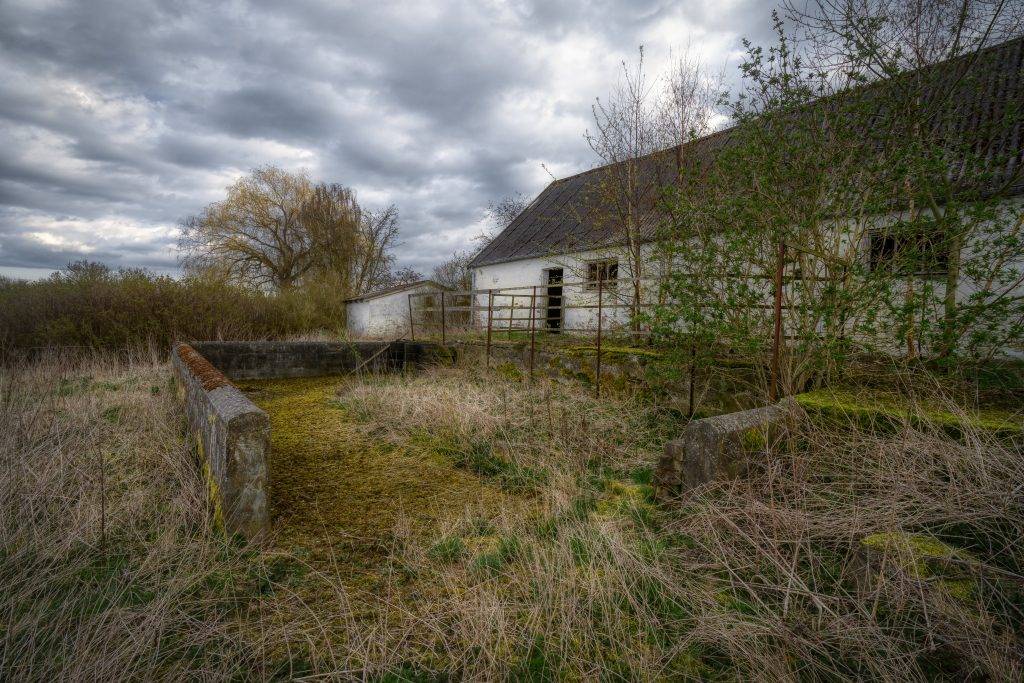
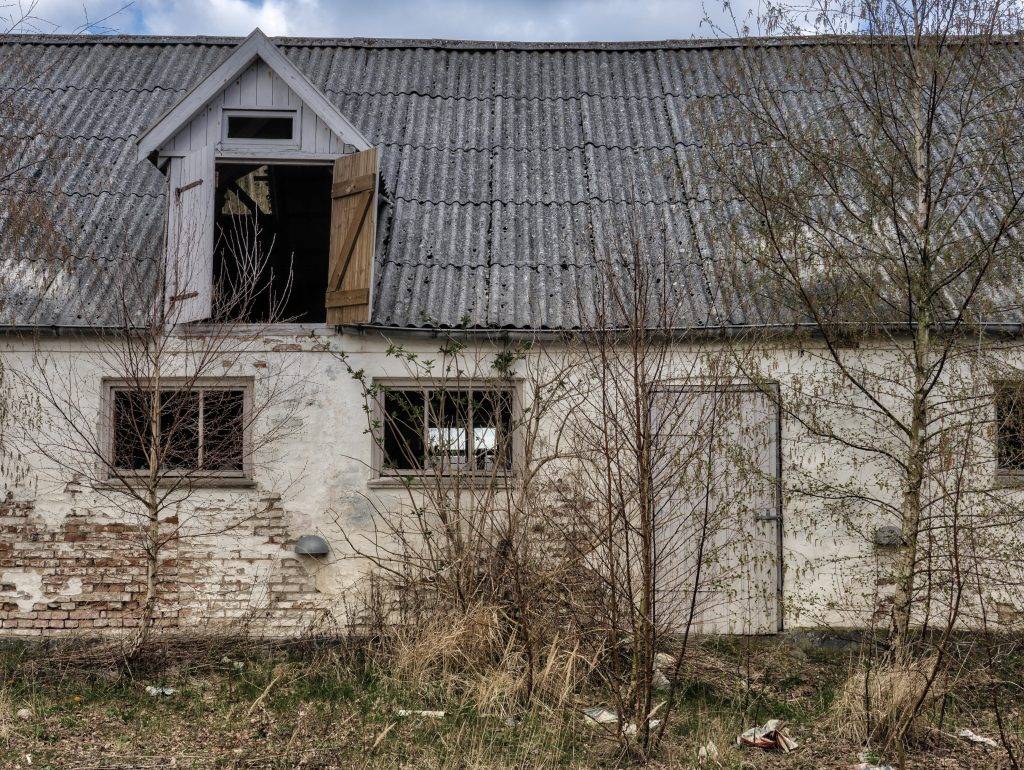
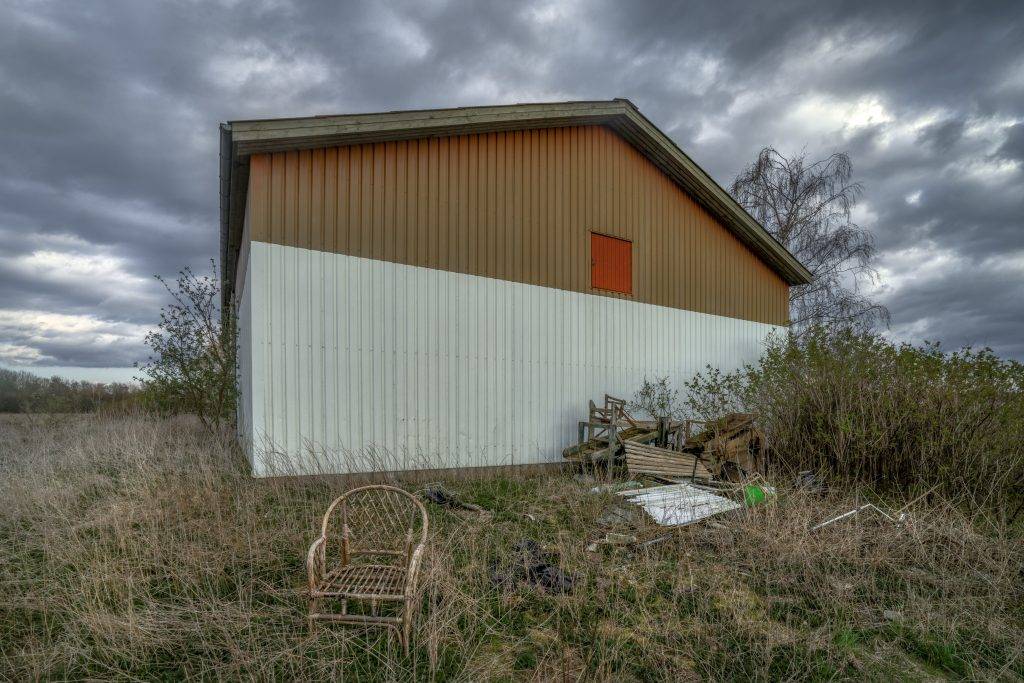
As I circled the house, it became more and more obvious that the farm had been in a state of abandonment and decay for years, possibly a decade or more. The walls were crumpling, trees were growing too close to the buildings. The inside of the stable showed no signs of animals having been present in ages.
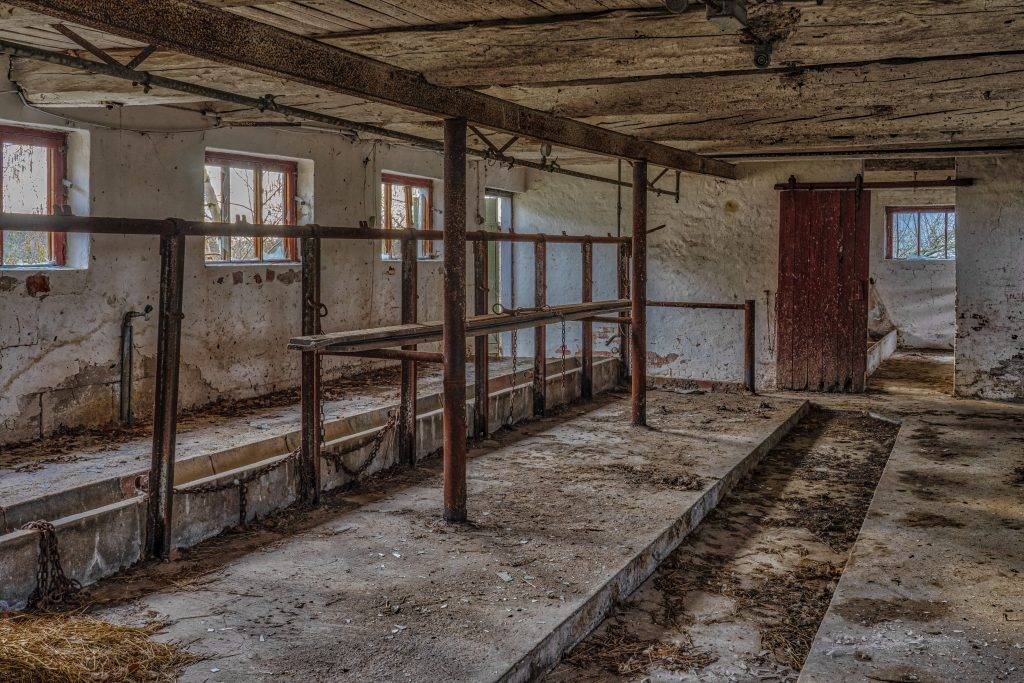
One time, however, I stopped in my tracks. A tricycle - the kind that old people use - was parked in the front yard. Was someone here after all? But no, at closer inspection I could see that there was no air in the tires. It had been sitting there since whoever lived in the house left for the last time.
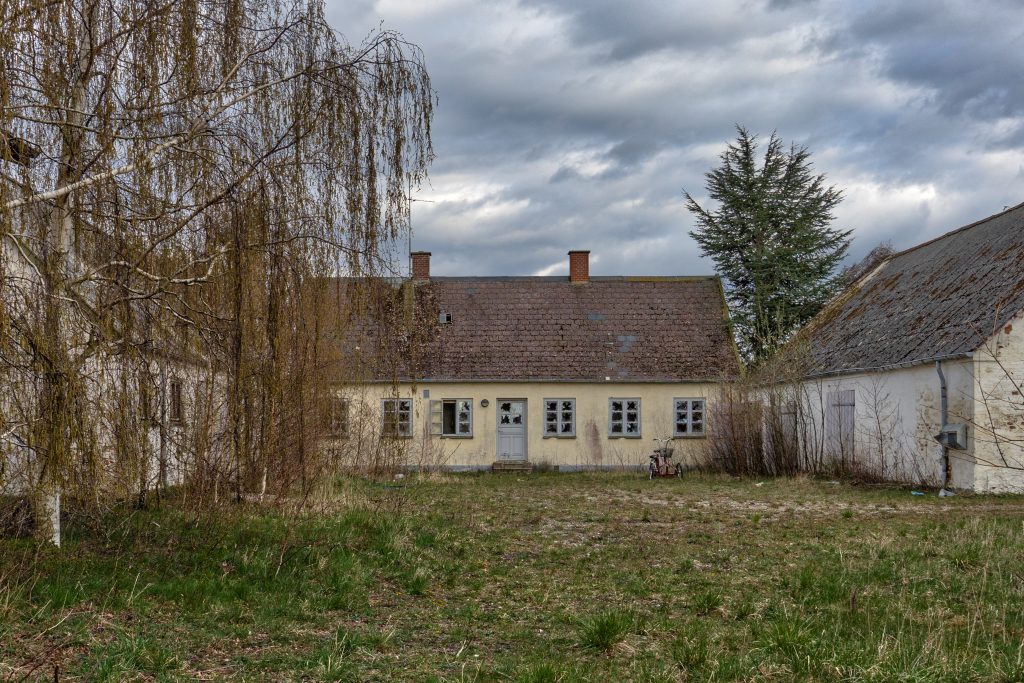
Maybe it was the tricycle, or maybe it was entering the below little backyard that suddenly made me envision life as it may have played out when it still existed here, and what led to its demise. Children running around, eventually growing older, moving away, uninterested in carrying on this farm that may have been in the family for generations. The old farmer and his wife, working the fields and livestock, until one day one of them dropped and could no longer work, leaving the other one lost and with no choice but to move into a retirement home for whatever time was left.
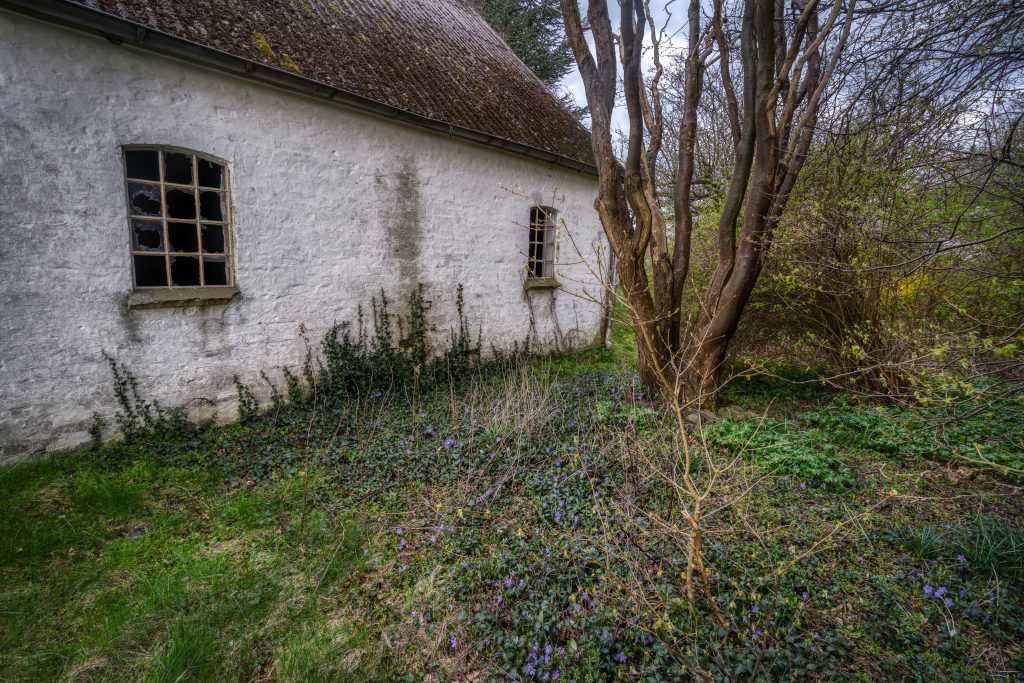
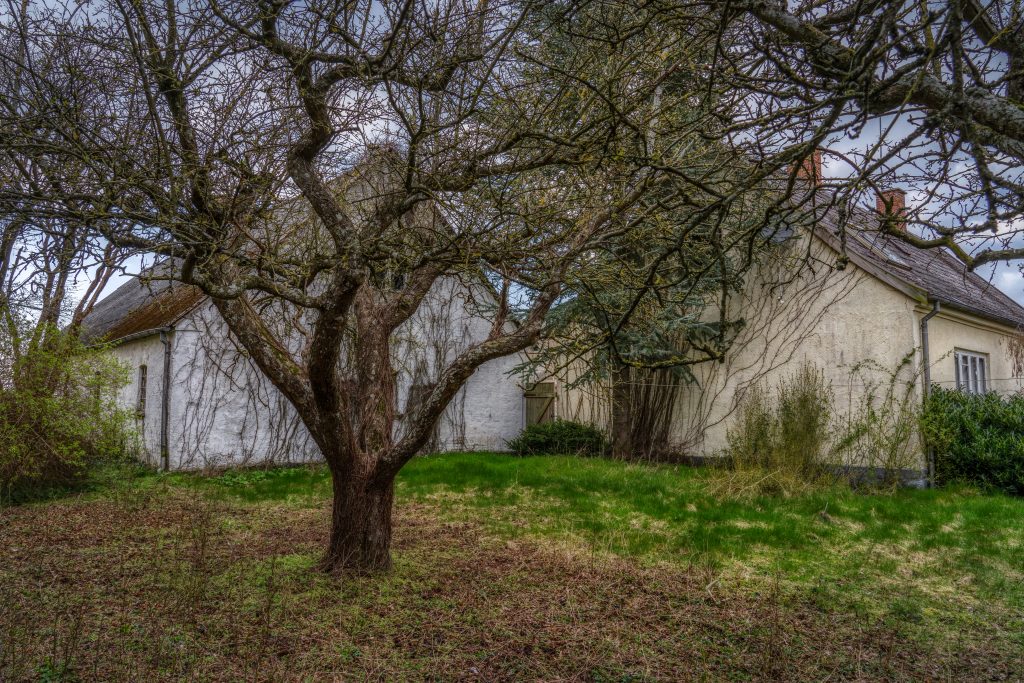
The sun was starting to set, and it was time for me to leave my new discovery behind. As I walked home, the passage of time felt more present than ever before. In less than a week I turn 50 years old. If the speed with which the last 20 years have gone by is any indication - and I fear that it is - the time when whatever traces I'm leaving behind start to fade is in sight. It may not be in shape of a farm, but it will probably be in the shape of what I have created on websites such as this one. And all these images, and thousands more, that no one has ever seen and no one ever will.
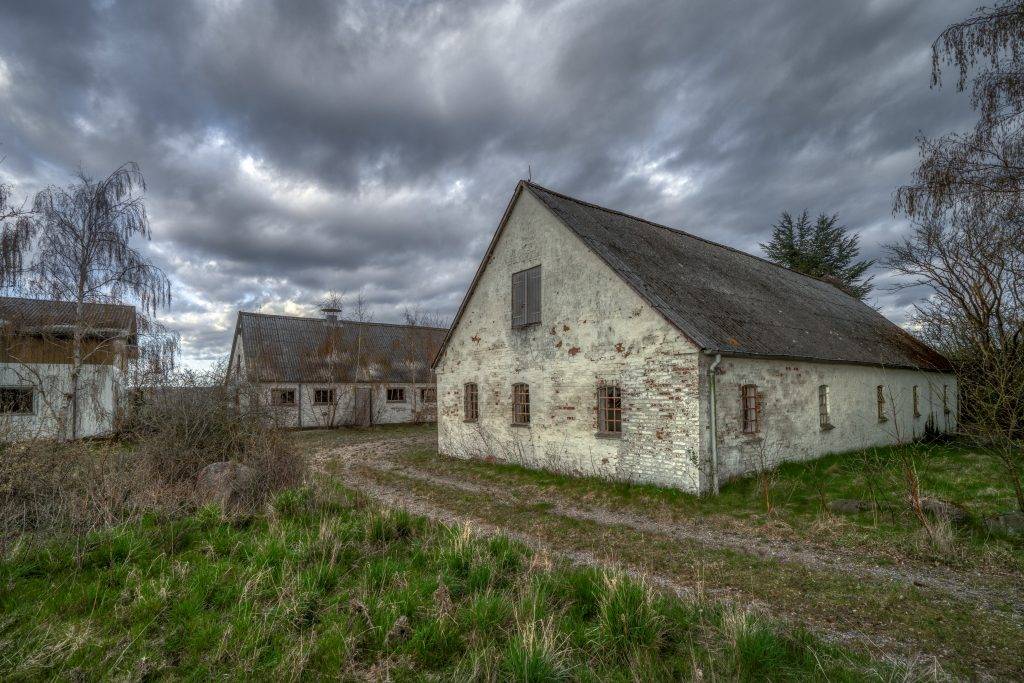
But that's okay. When I got home and told my wife what I had experienced, she said something to the effect of, "Before our house was built, this area was someone else's untouched ground, and they were probably pretty unhappy that new houses were being built."
Her words stuck in my mind. The world is constantly changing. Generations follow generations, and the current generations have no say about the future. We have to accept that the world is only on loan to us. And we just have to make the best of it while we can.
The old farm house will probably be torn down one of these days. The new neighborhood will rise from the ground. I will find new places to shoot my images that few people will ever see. And one day when I'm gone, a server will be turned off and the images, too, will be gone forever.
But somewhere in the world, another middle-aged, overweight amateur photographer will leave his house and go out to shoot his pictures.
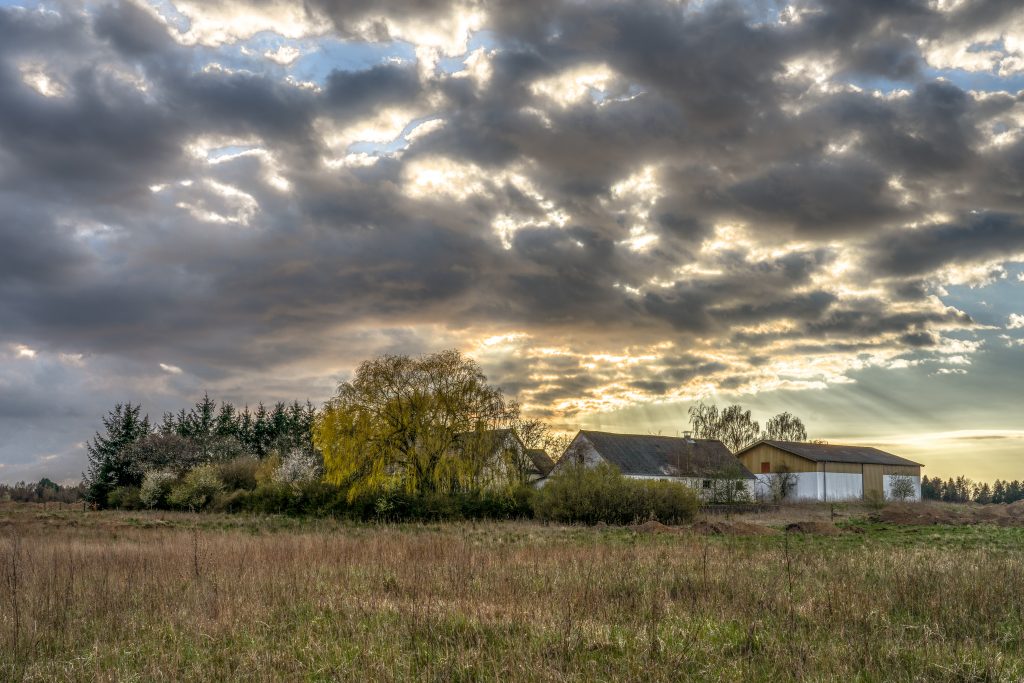
The statement in this post's headline is one that I hear quite often when I show my pictures to people, whether it's family or friends.
Usually, I quickly switch to something else on my phone or computer, or whatever I was using to present my pictures on, and change the subject. Because I know what the next part of their sentence is going to be, if there is one: "but it doesn't look like the real forest/street/beach/sky".
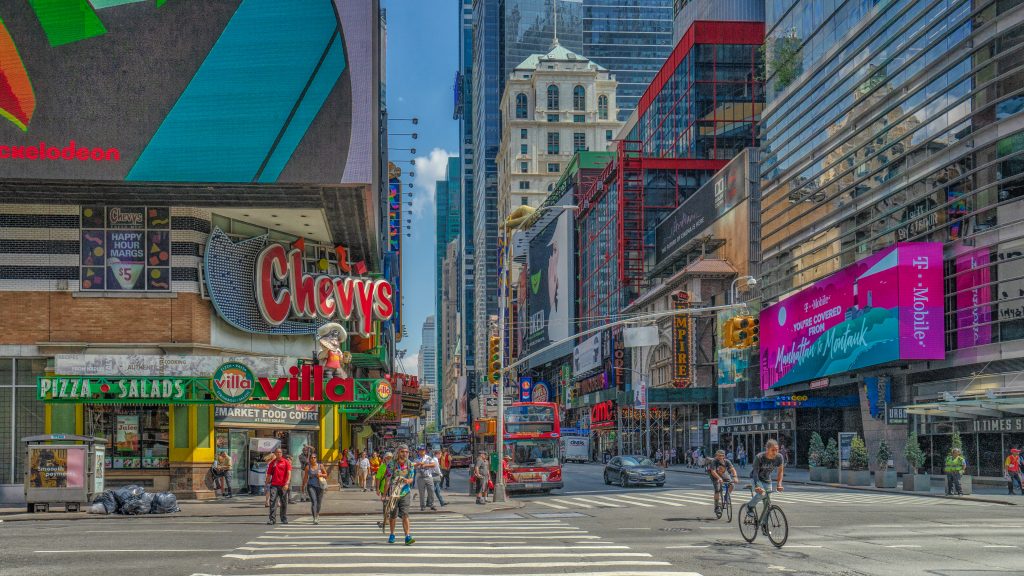
It's never a good thing for an artist to have to explain their art to the viewer. If they don't get it, they don't get it. Not everybody has the same taste. You can't please everyone. Yada yada, yada.... But I can't help feeling that they are missing the point. My objective when creating an image is not for it to exactly resemble what I saw with my eyes, it is for it to resemble what I felt in my heart and soul... and to have the viewer feel that too. If you are not open to letting yourself be emotionally affected, but only look at whether or not it matches what you perceive as "reality", it's your loss.
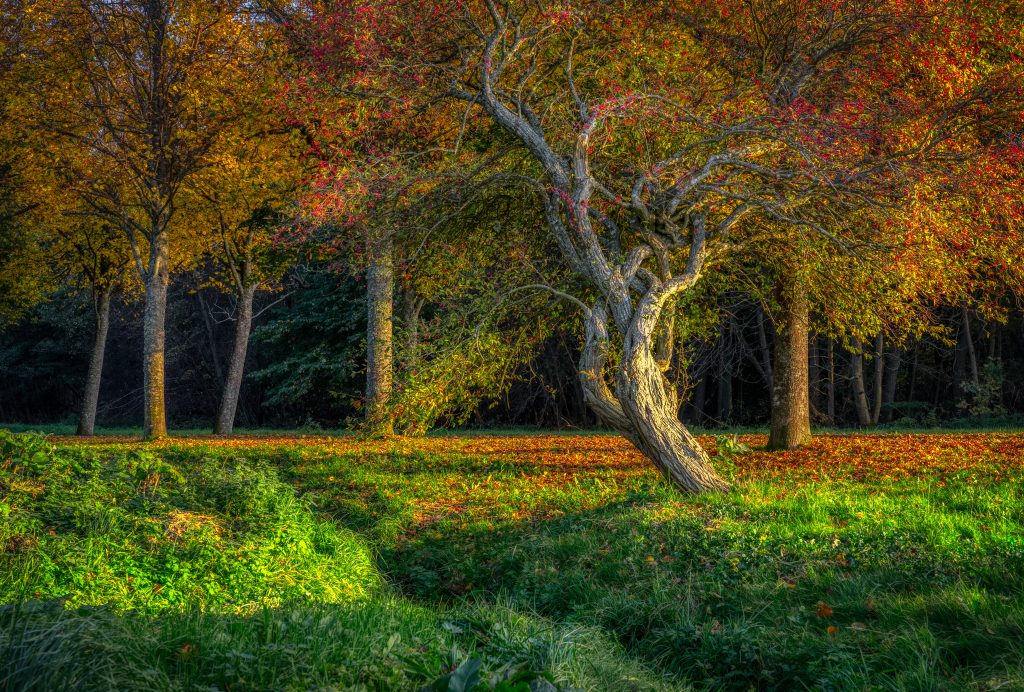
The thing is, if I look at a picture that exactly resembles what I saw with my eyes, it will not affect me in the same way it did when I was in the situation. Why? Because it's a picture! It's not reality. Reality has so much going for it that it becomes an uneven match against an image on a screen or on a wall. Reality has size, it has three dimensions, it has movement, it has sounds and smells, it has the viewer being in the middle of it.
So, in order to compensate for those deficiencies, an image must have something else that reality didn't have, and that's where in some cases additional colors can be a tool. It could also be to add some romantic blur, or make the clouds a little more dramatic than they really were. For instance, if, in the situation, the "scene" felt dramatic, but the image doesn't show it due to its single-dimensional and single-sense qualities, there is nothing wrong with emphasizing the things in the image that at least point in the right direction, such as making clouds grayer and more defined than perhaps they actually were.
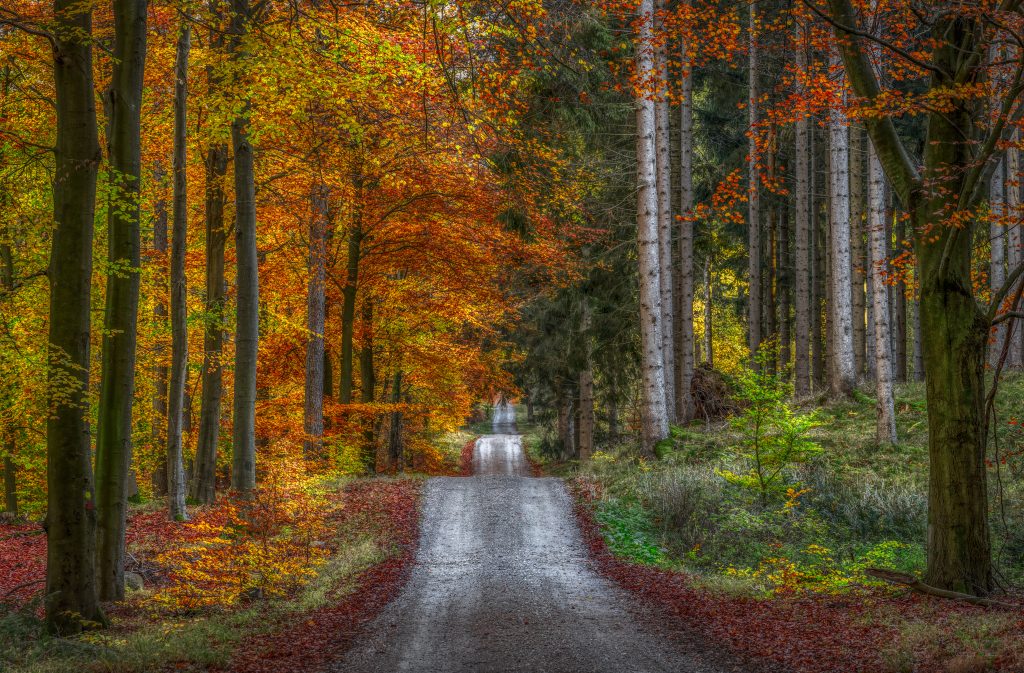
Another point I would like to make is that I actually want to question the so-called reality that many people seem to subscribe to. It seems to me that some people think that an unedited photo, per definition, is closer to reality than one that has been edited. The truth is that one is the camera's interpretation of reality and the other is a human being's interpretation of reality. Do you really think that the camera's interpretation is always more accurate than the human being's who took the picture? Maybe neither one can be completely accurate, but in that case, I will usually find the human being's interpretation more interesting. Of course, a human being can completely ruin a picture with too heavy-handed editing, and I'm sure I have been guilty of that too in the past. Some would say I still am, but I choose to believe that, as I have become more and more conscious of what I want to achieve, it doesn't happen quite as often.
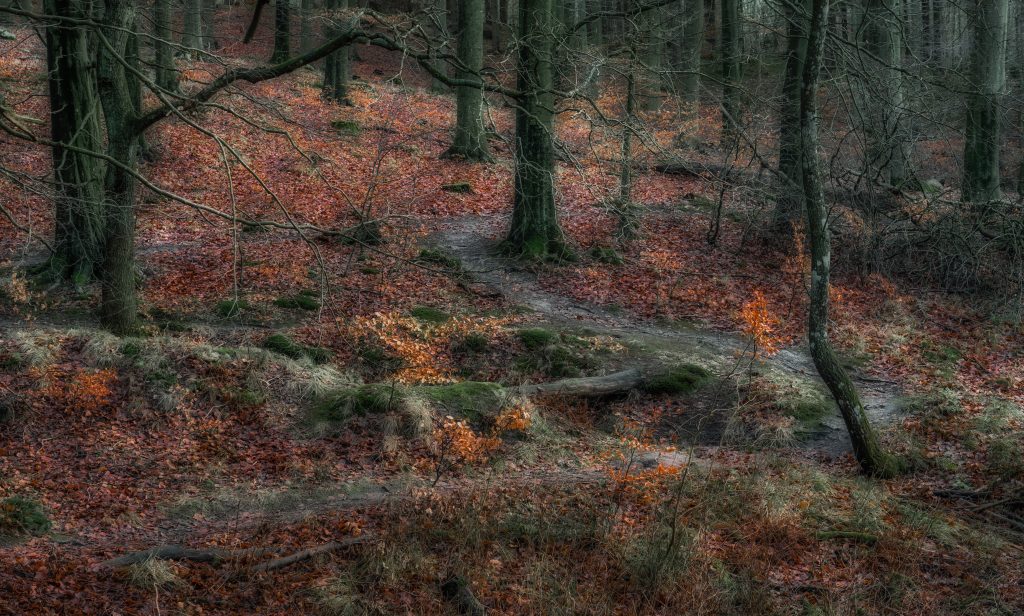
When all is said and done, I can't rule out that I'm just not very good at conveying what I want to convey with my images and that the "but-it-doesn't-look-like-reality"-segment of the population is right. Or that, realistic or not, the same people would totally get the image if I was just better at editing. But I also have received enough awards and love on places like Viewbug and GuruShots that I feel fairly confident that I'm not completely hopeless at what I'm doing.
In the end, I do with my images what I feel is right and what brings up the same feelings in me that I had in the situation. Whether it brings up any - or the right - feelings in anyone else is another matter. All I can do is try and hope that what I do strikes a chord with you.
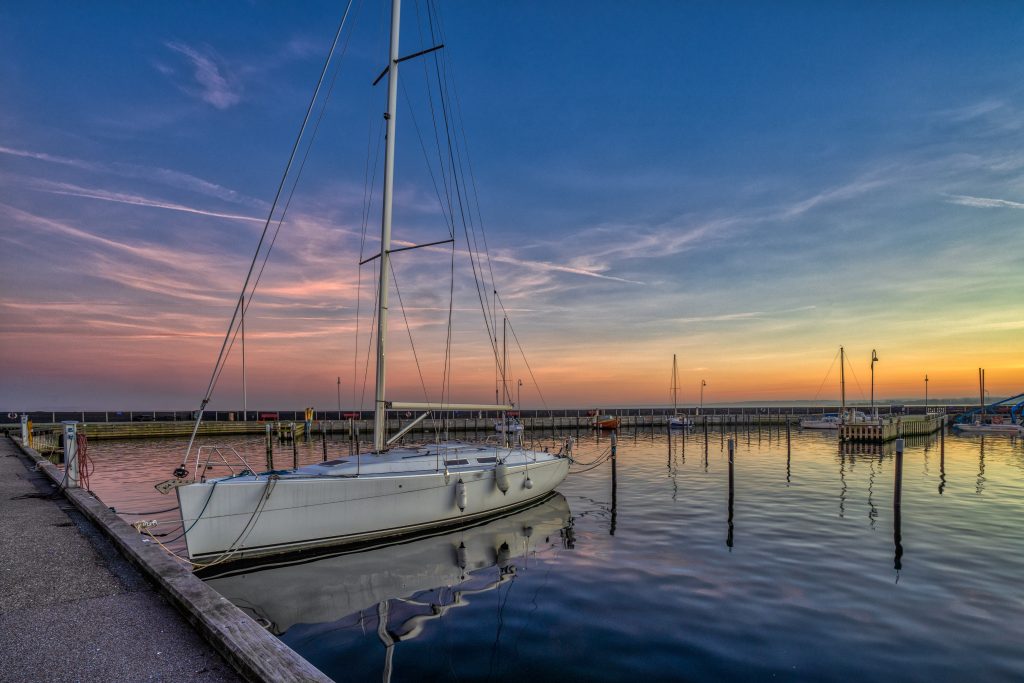
I read somewhere that if you want readers for your photography blog, you need to offer tutorials and practical advice. I haven't done much of that, because as an amateur who struggles with even the most basic skills, I really haven't felt qualified to tell anyone anything about how to go about their photography.
Besides, I have an ambiguous feeling about photography tutorials. Photography is basically "seeing" and then, with your camera, managing to distill what you see into an image. I can't help you with the first part. You have to do your own seeing. If you go into a forest and don't see anything, then forest photography is just not for you. I'm not sure I can help you with the second part either - the distilling. I'm not very conscious about it myself. It just happens, not least in the post-processing phase where I try to emphasize what it was I saw in the situation.
I won't go into the post-processing here, as it would make this post too long. This is all about what you should and should not do while you are out there in the woods with your camera.
But despite my reservations, as the self-proclaimed Denmark's Number One Forest Photographer, it is only fair that I dip my toe into this new territory and offer my completely professionally unfounded, homespun, possibly dangerous, dos and don'ts of forest photography, in no particular order. Yay!
1. Get off the path. You find the best compositions by leaving the path and finding the untouched spots where no one has gone before, let alone with a camera. Sure, your feet will get wet, you will be stung by nettles, but it's worth it.
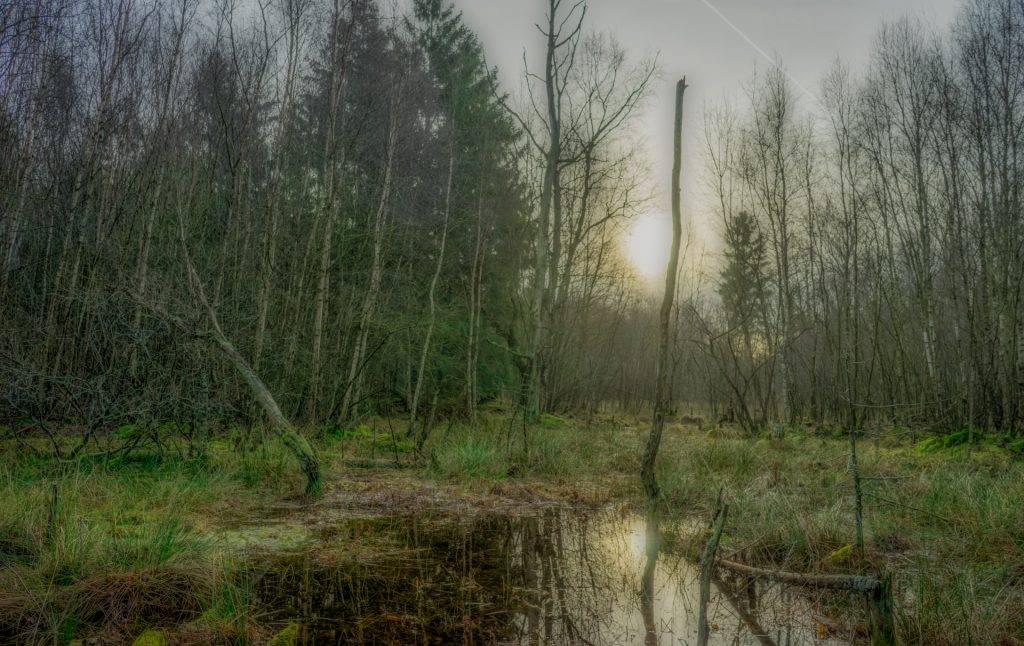
2. If you get off the path, don't wear shorts. Wet feet and nettle stings may be worth it, but being infected by a wood tick could very well not be worth it. And yes, I've tried it and I was fine, but I may just have been lucky.
Don't get eaten by a bear either, if you live in a country with bears.
3. Look for the patterns in your surroundings and then capture what breaks the pattern. Like in the below image, the fallen tree is what makes this image interesting, but it's only interesting because all the other trees constitute a whole.
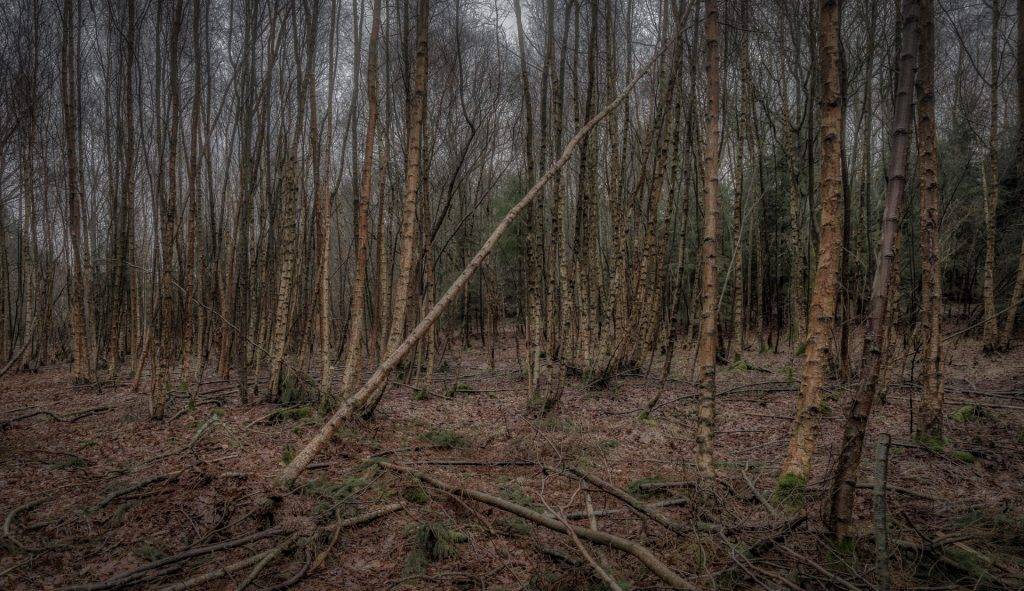
4. Days with clear blue sky are perfect for forest photography. Why? Because that means you will have lots of sunbeams coming through hitting the leaves and trees in gorgeous ways. Besides, clear blue sky doesn't work too well for outside-the-forest landscape photography, so spend those clear days in the woods instead.
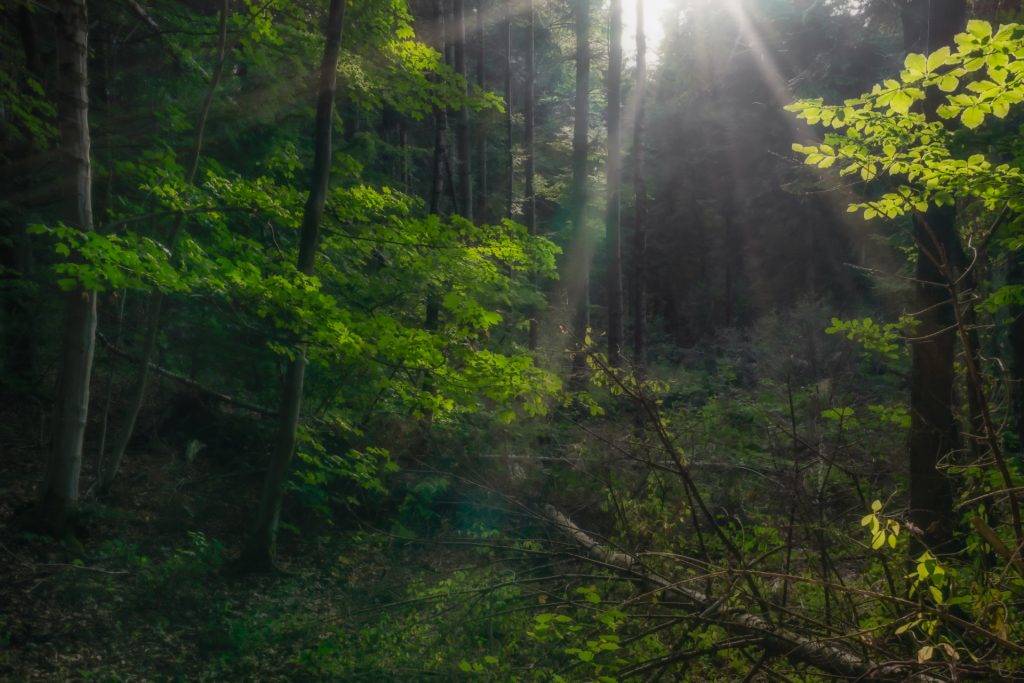
5. Compositions are everywhere! As you walk through the forest, look to your side, look behind you, and look up. The compositions are all around you if you pay attention. I call this one, "The Man in the Tree".
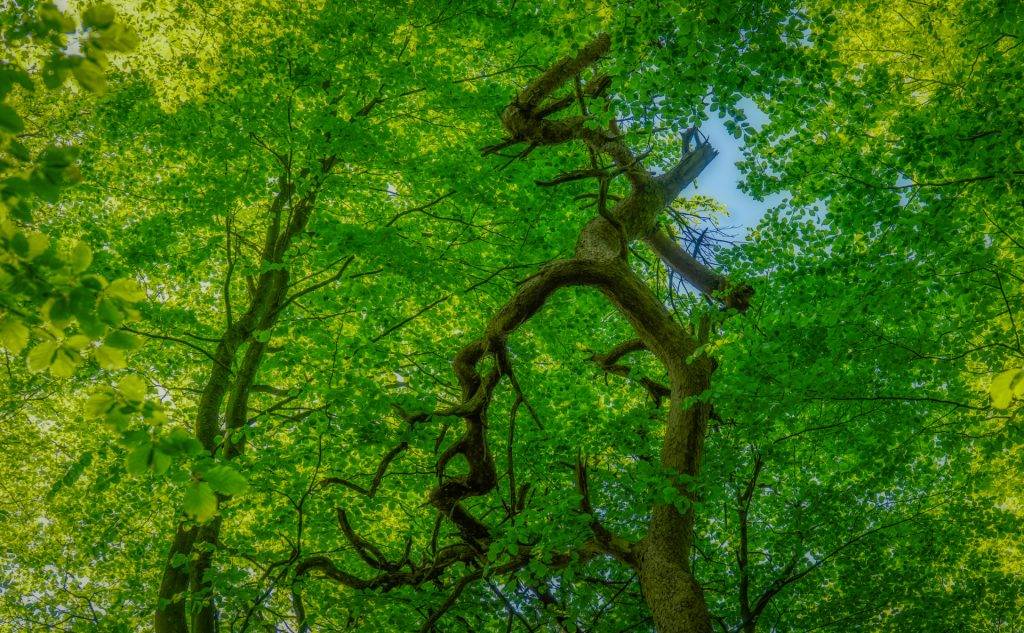
6. There is no bad season for forest photography. They say fall is the best season with the leaves turning orange, yellow, and sometimes even purple, and sure, that may be true, but even in the most dreary, yucky, muddy, gray part of winter, forests have lots to offer. Make a virtue of necessity and capture the dreariness, the yuckiness, the grayness. And notice how completely different the exact same location looks during different seasons.
[ics-comparison-slider id=1]
7. Long exposure photography is good for many things, but be careful when using it in the forest. The least bit of wind in the leaves will make your images blurry at slower shutter speeds. Of course, I can't give you a minimum shutter speed to go by. It depends on how strong the wind is and how much movement in the leaves. Just be aware of it.
8. Use a tripod. Even though I just stated that long-exposures in the forest can be a problem, you are often caught in the dilemma between using a low ISO to avoid noise in the shady parts and keeping exposure times down enough to avoid blur in the leaves. Forests are by definition relatively dark places, and as a result, don't expect to be able to use really fast shutter speeds either. Handheld photography may be possible on bright days in the forest, but usually the result is noticeably better when you use a tripod. Besides, because forests form a pretty good windshield, there will be days that are completely still where exposures of several seconds will come out just fine.
9. As you leave the path, try to make your way downhill. Eventually you will come across water in the shape of little creeks or tiny forest lakes. Water = reflections, reflections = good.
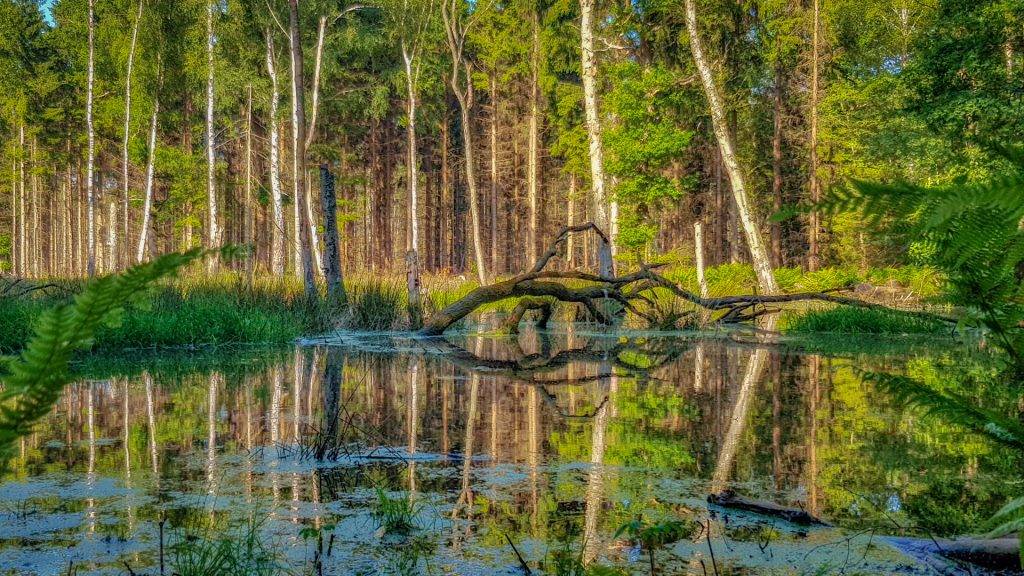
10. A tree is not just a tree. The forest consists of tons of trees, and sure, most of them are rather indistinct and non-photogenic. But keep your eyes open and you will see exceptionally beautiful trees that just stand out among all the others. Grab them.
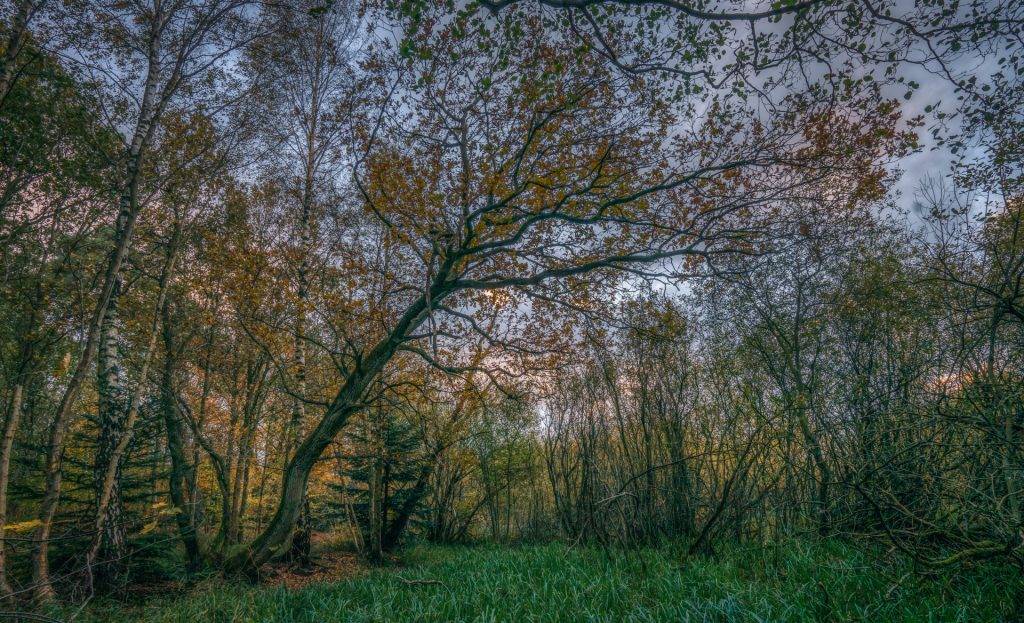
11. Some trees are worth more dead than alive! For some reason gray, leafless and lifeless trees make for great photography subjects. This image is the only one not from Denmark, but from Idaho. I called it "The Ghost".
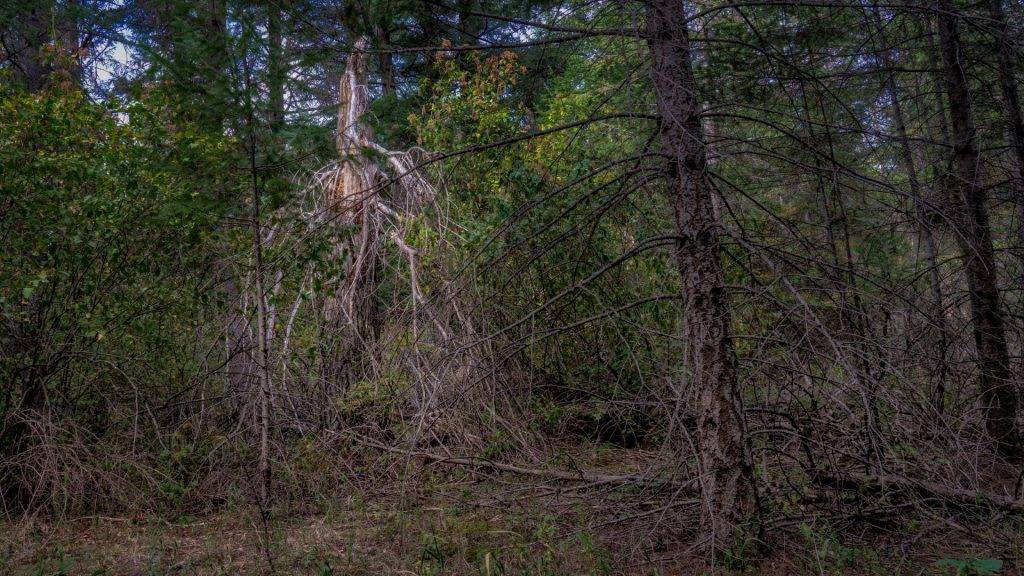
12. You don't have to go deep into a forest to find the best compositions. The edge of the forest, or an edge to a clearing or a lake in the forest, are gold in forest photography. That's where the light is at its best and where you can find interesting contrasts and focus points.
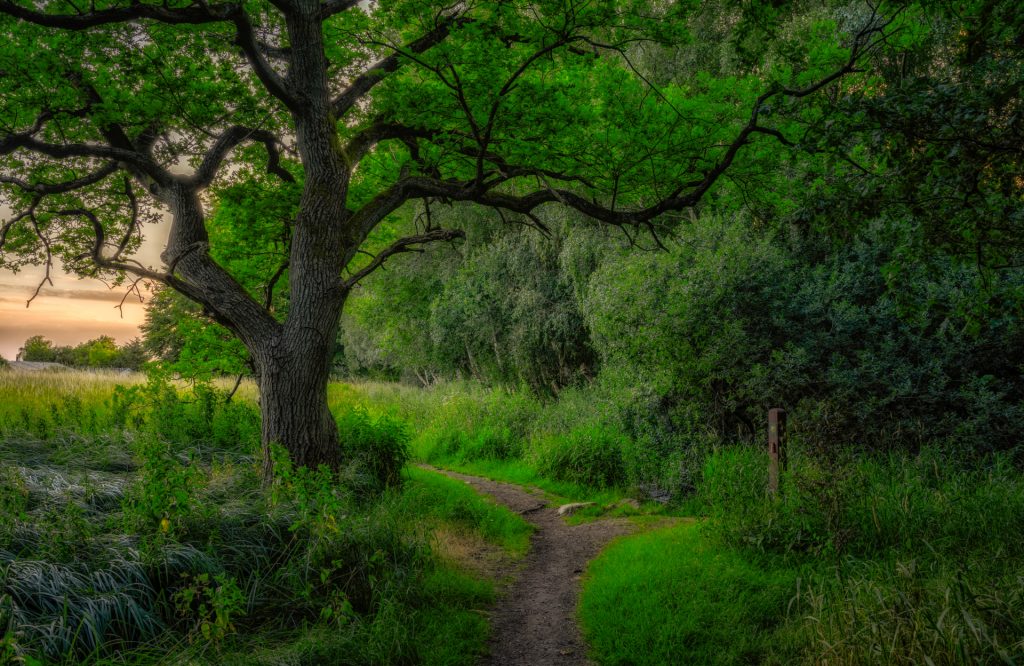
So those were my best tips for forest photography. Since I mostly operate in Danish deciduous forests, I can't guarantee things work quite the same way in other types of forest in other parts of the world. What I'm certain goes for all forests is that they provide an endless array of opportunities for photographers if you keep your eyes open and are not afraid of straying from the beaten path.
Me? I forget my camera. Sure, it was just a quick walk in the local area, so no big deal. Still, when I'd set up my tripod at the nice spot I'd just found, where a low sun was lighting up the landscape in amazing saturated colors, and looked into my bag that contained my lenses but no camera, I felt like the dumbest photographer on the planet. The camera must still be sitting at home on the dining table where I had put it down after checking the SD card and battery...
Well, there was nothing to do other than to fold up my tripod and zip my backpack. And to grab my trusty Samsung Galaxy Note 8 cell phone whose camera is more than adequate for situations like this. I decided to take the opportunity to test the pro-settings of the camera that allow you to shoot in RAW and control the camera manually, much like you would with a DSLR. I've never really bothered doing that since I usually have a much better RAW camera on me.
So here is the scene that lay before me. How pretty is that?! While the sharpness of the image is certainly nowhere near what I can achieve with my Sony A7II, at first glance you really can't tell that this is a cell phone image.
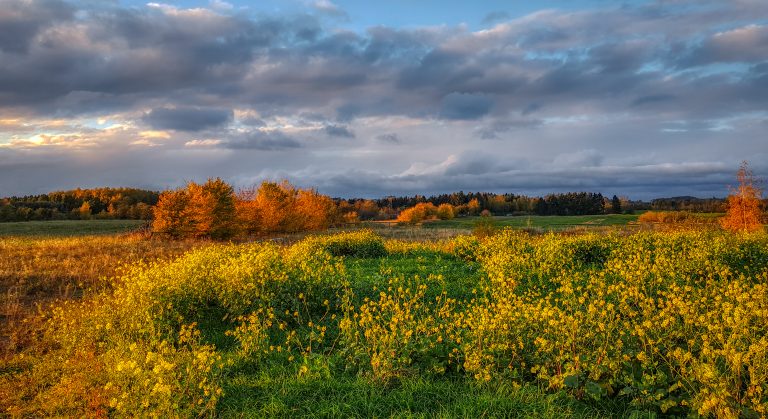
One of the things that you can do with Note 8's RAW camera - or Pro camera as it's called - is to control the basic settings that you know so well from your DSLR camera, such as exposure, aperture, and ISO. That's a huge advantage. Most daylight images - and even images such as these that were taken close to sunset - will have parts or all of the sky blown out if you rely on the phone's automatic settings. In these pictures I was able to optimize the exposure to the sky and then brighten the bottom part of the image in post-processing, just like I do with my regular camera.
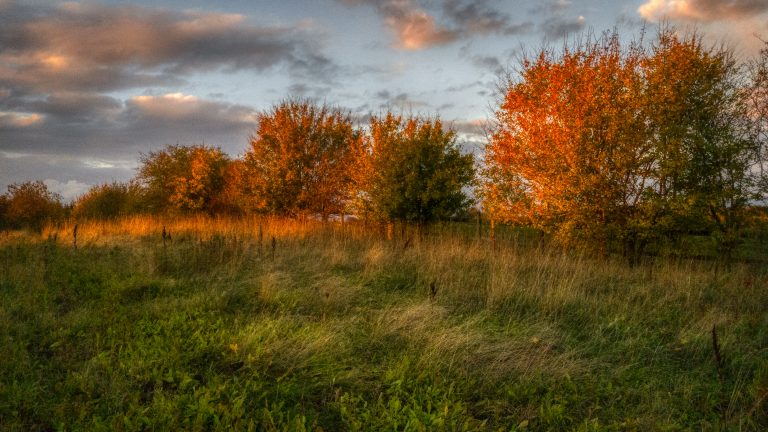
The few times I previously have used the Pro-mode of the phone camera, I have let all the settings be up to the phone. That's not recommendable. Especially in low light surroundings. Then the phone will put the ISO to a ridiculous level that completely drowns your image in noise. For these images I set ISO to 400. I didn't touch the aperture setting. Apparently that means the phone sets it to a whopping f/1.7, which resulted in shutter speed times at no less than 1/1000 seconds.
So while I'm generally very happy with the result, if you compared them with similar images taken with my Sony on a tripod, it would be an uneven fight. Even in post-processing, it seemed like the phone's RAW format wasn't quite as generous as that of my Sony when it came to revealing details in the shadows and letting itself be molded the way I wanted it.
But again, I simply can't complain. The image quality along with the beautiful light that descended on the area on this particular evening, make these photos rank among my favorites of the season.
Below are a few more examples from an afternoon that started with me wanting to hit myself with my own tripod for forgetting my camera, but ended as a pleasant surprise and some really nice images.
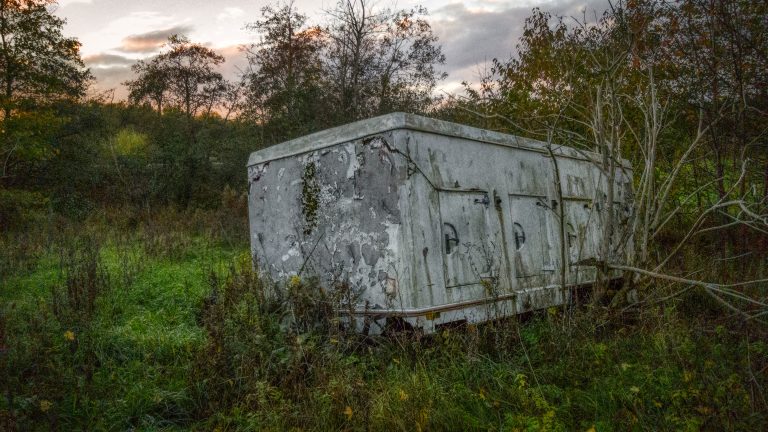
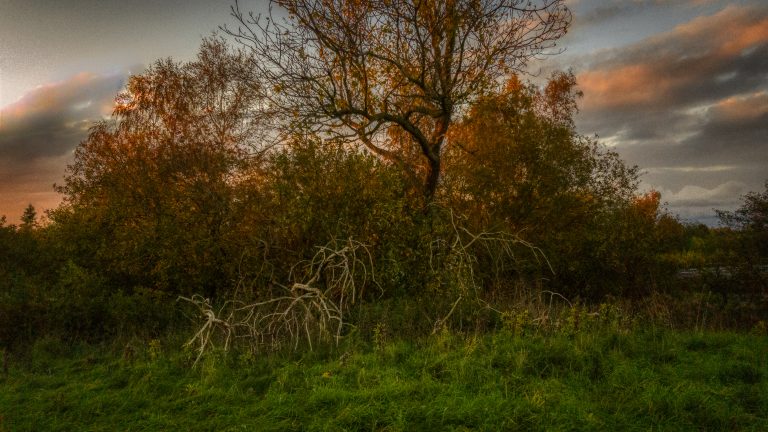
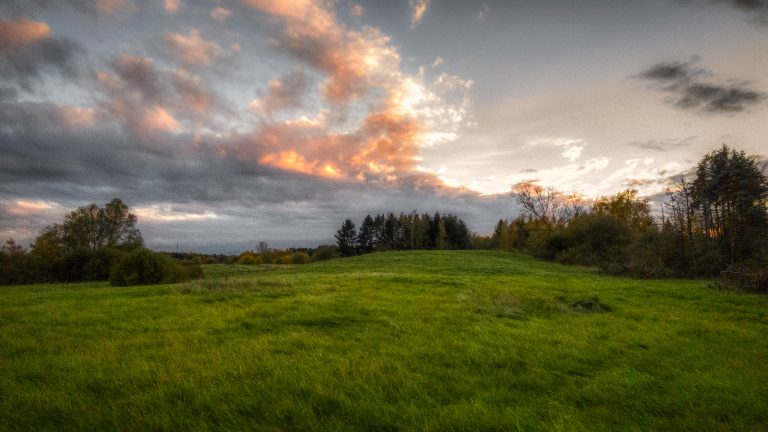
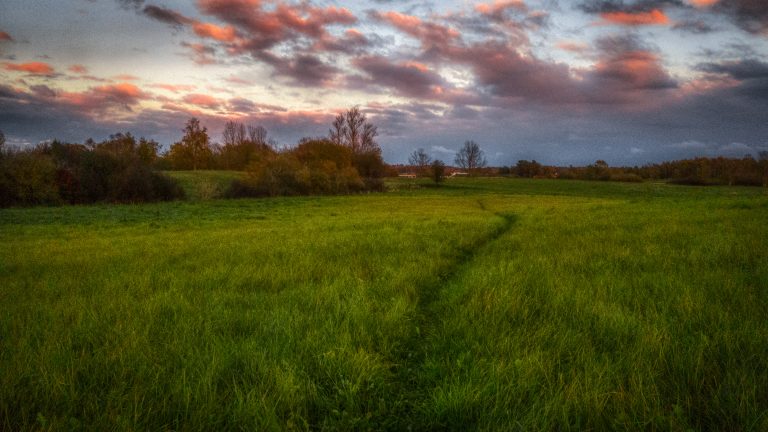
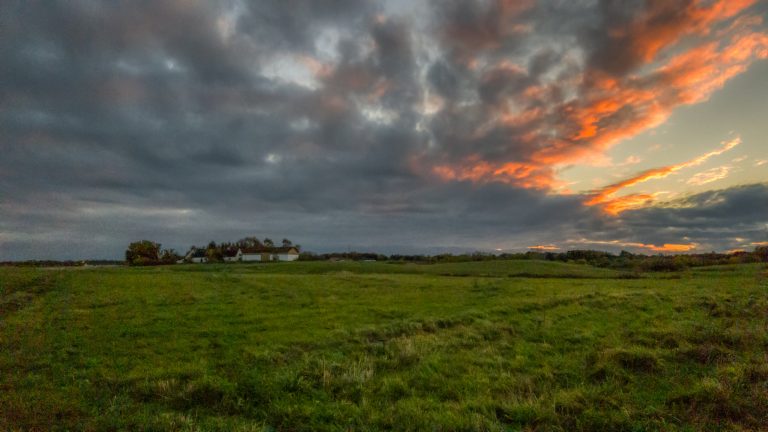
Considering how few people actually see my photography - most of my images are only ever seen by me - I take it very seriously. I am finding my niche more and more in Danish landscape, and forest areas in particular. I love the forest. I grew up a few hundred meters from a forest and moved to my current home partly due to its vicinity to forest land.
But forest can be a challenging subject. Not for lack of compositions. But in order to take good forest pictures, you need to literally get off the beaten path and find the spots that no one ever sees. That is not always easy.
The other night I went back to the Strødam nature enclosure. I have written about it in the past, before I really knew what it was. I just knew there was a fence around it and signs telling you to stay out. Since then I have learned that it's an area owned by the government used for nature research. They are basically letting an area of forest, lakes, and meadows take care of itself without much human disturbance. There are tons of birds and deer, and a herd of more or less free-roaming cows. In other words, a paradise for nature and landscape photographers. Except, photographers are not allowed to go there.
Well, back in February part of the fence around the area was suddenly gone. I had a feeling they were just replacing it, because it was old and worn out, and it turned out I was right. But for a few weeks in February I could at least pretend I didn't know that I wasn't supposed to go in, so I did. I have in fact shown you a few pictures from those excursions without mentioning where they were taken or the circumstances. But anyway, as much as I love those gray, dreary images of the winter forest, I felt I had to return to see what it looked like in the spring.
So, I shouldered my camera bag, saddled my bicycle, and rode out to the area a couple of hours before sunset. I knew there was an entrance that did not have a gate. A discreet sign tells you to please stay out, but that's all, and on this evening I happened to look the other way as I passed it. Or at least, that was going to be my story if anyone asked.
A few bigger paths traverse the area, so I was able to ride my bicycle as I started my penetration into the forbidden land. I had not gone far before I heard a loud rustling sound from the brush. I couldn't see what caused the sound, but moments later two deer appeared in a meadow next to the path. One of them quickly dispersed into the woods, but the other one stood there and watched me long enough for me to raise my camera and grab a picture. Unfortunately, I had the 16-35 mm lens on, so I couldn't really zoom in on it much, but I still like the result.
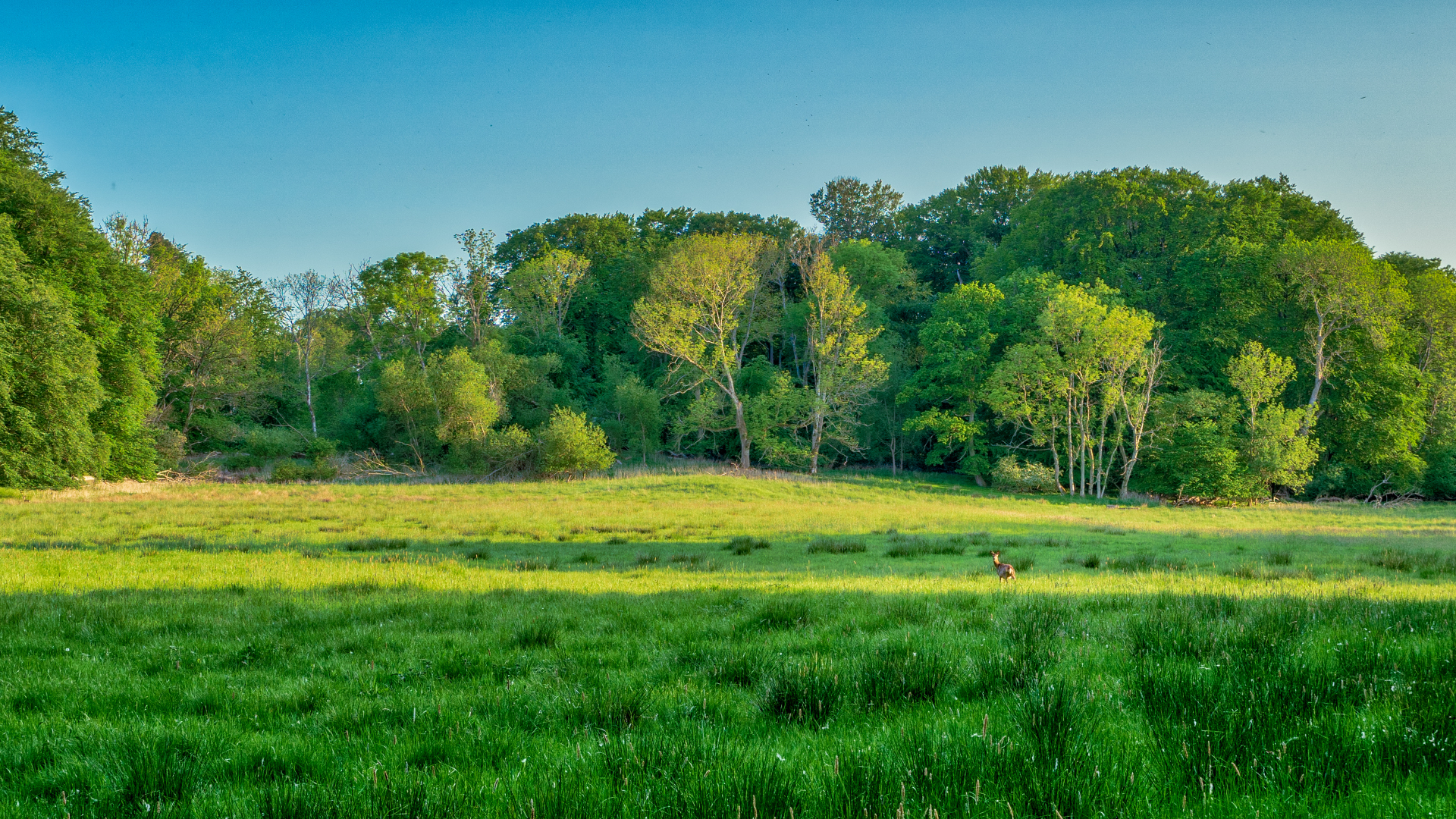 For the next hour or so I crisscrossed the area, setting up my tripod wherever a sunbeam flooded the forest floor, a branch reached out, a broken tree had been left to rot, or whatever else constituted a composition in my all too receptive brain. That is my strength and my weakness as a photographer. I see compositions everywhere, and that leads to too many pictures and sometimes rushed execution, because I have to go to the next spot and the next spot and the next. Still, I got away with this string of photos that have passed my own quality control.
For the next hour or so I crisscrossed the area, setting up my tripod wherever a sunbeam flooded the forest floor, a branch reached out, a broken tree had been left to rot, or whatever else constituted a composition in my all too receptive brain. That is my strength and my weakness as a photographer. I see compositions everywhere, and that leads to too many pictures and sometimes rushed execution, because I have to go to the next spot and the next spot and the next. Still, I got away with this string of photos that have passed my own quality control.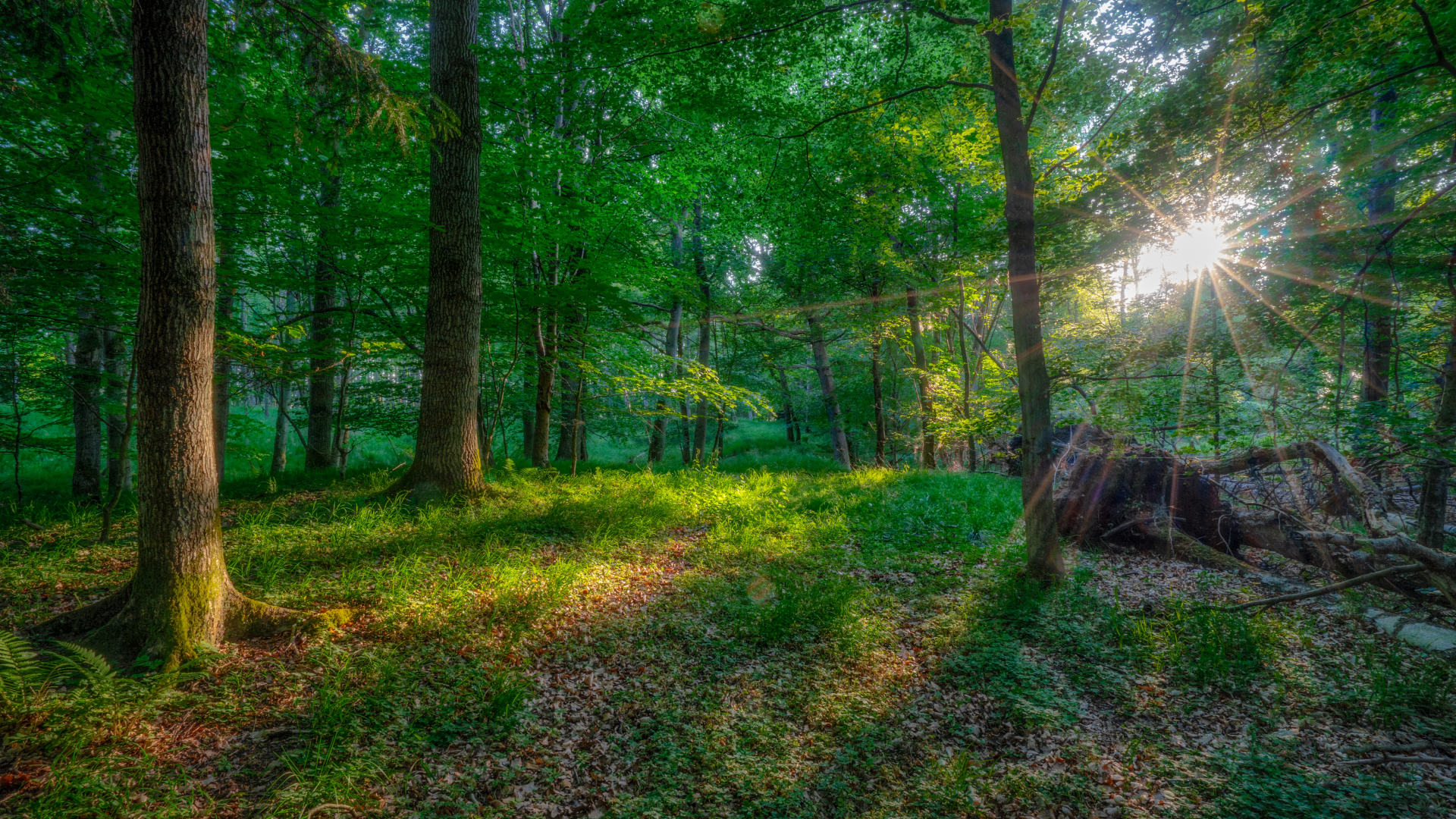
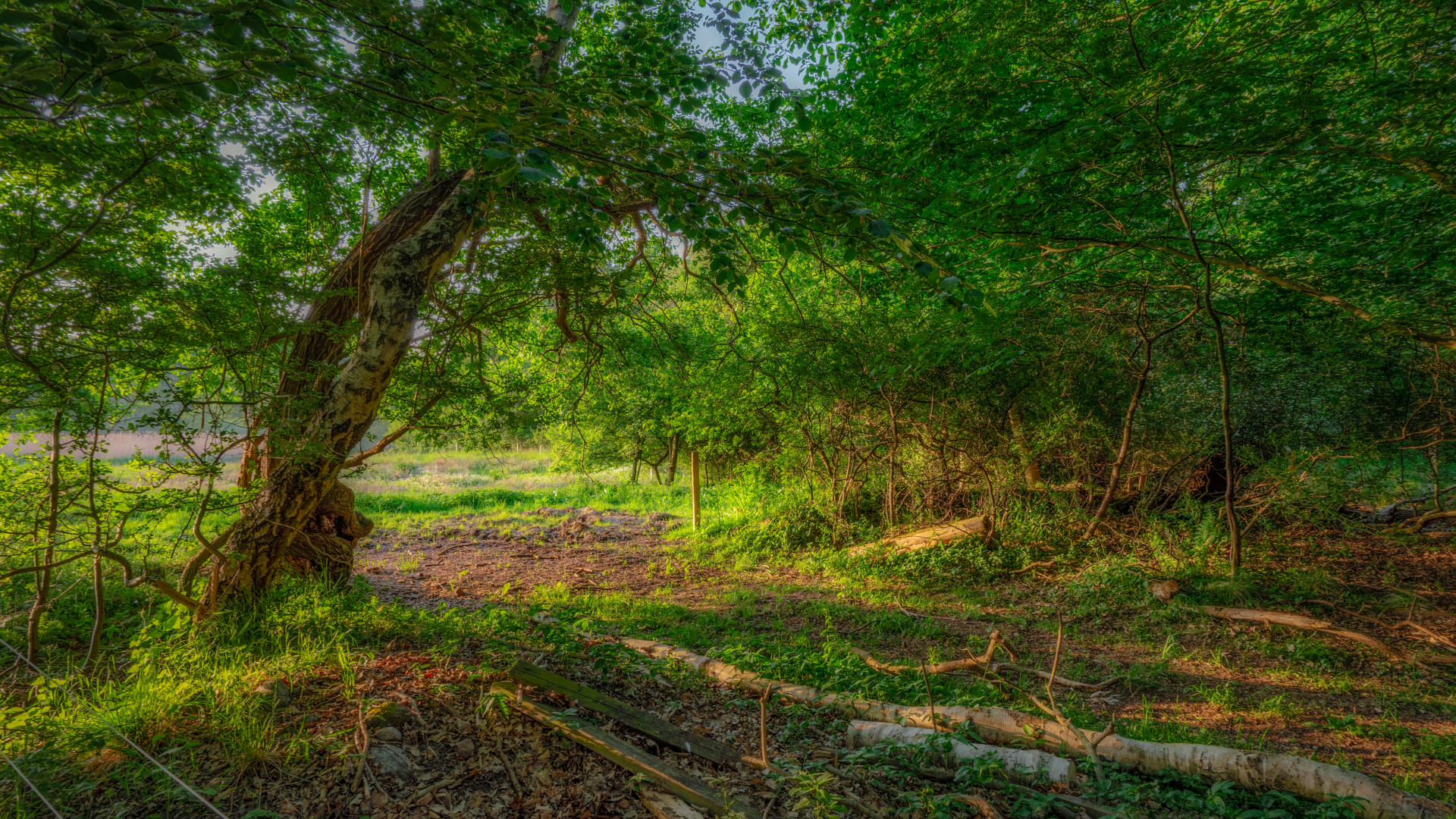
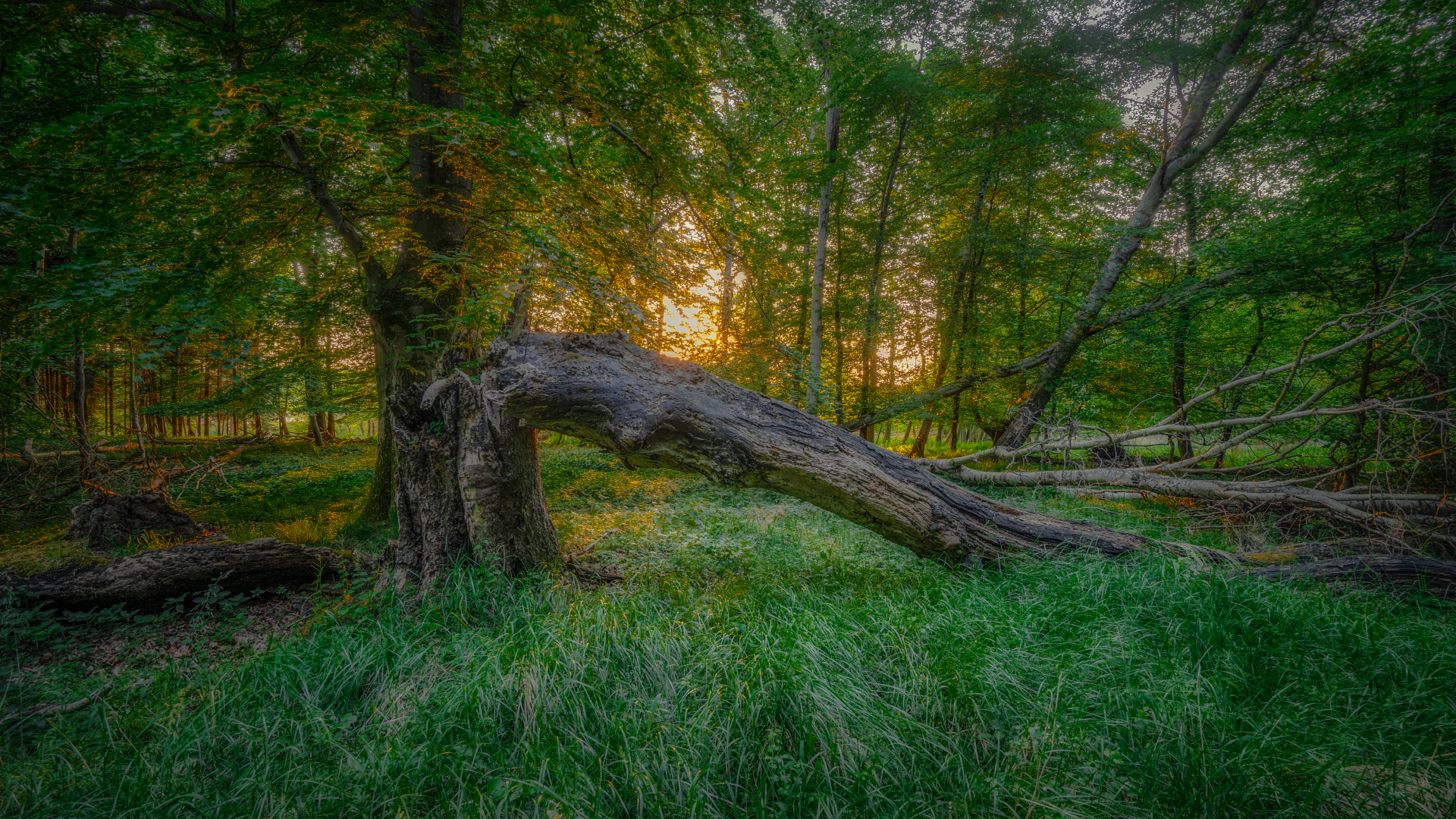
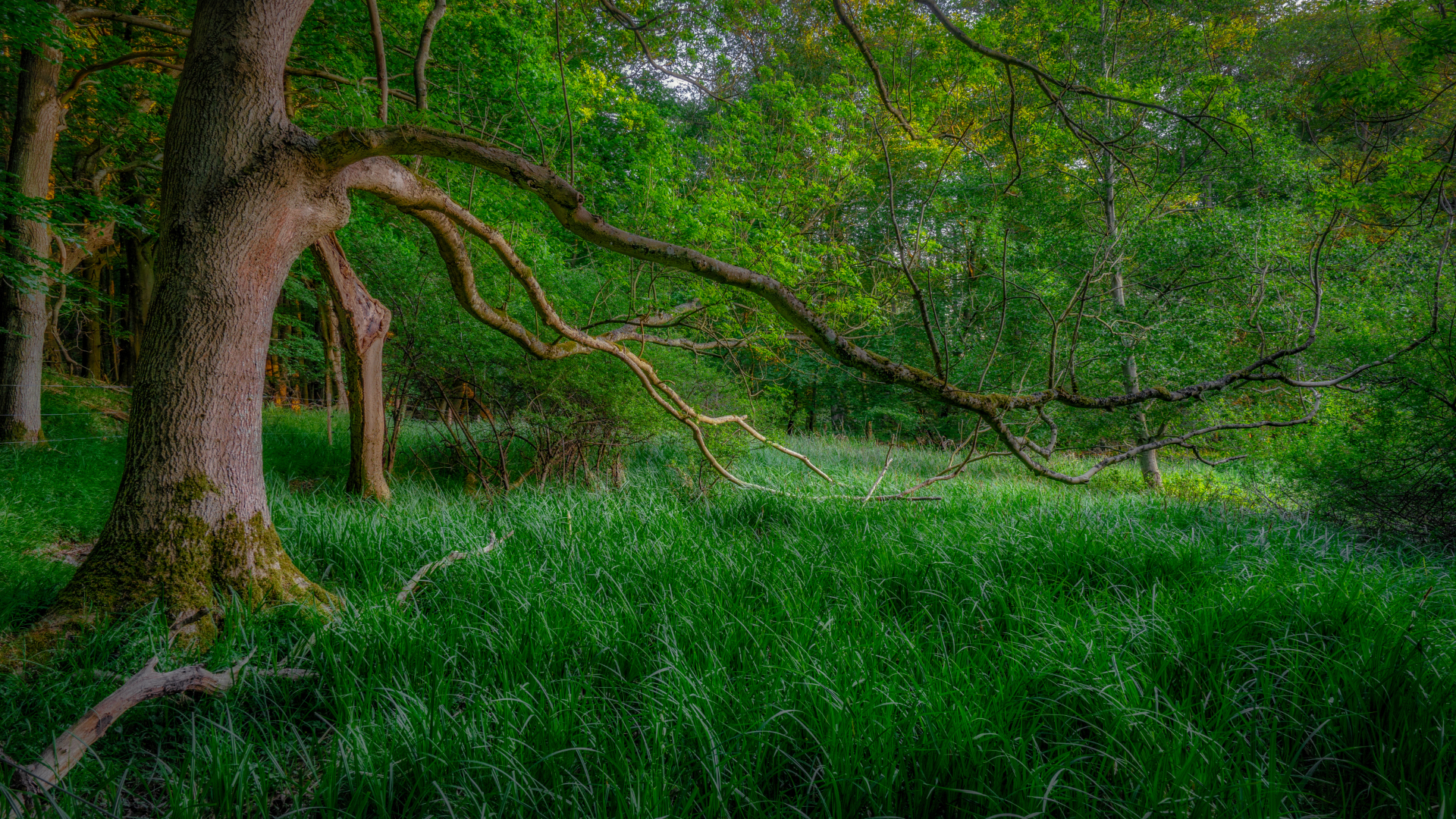
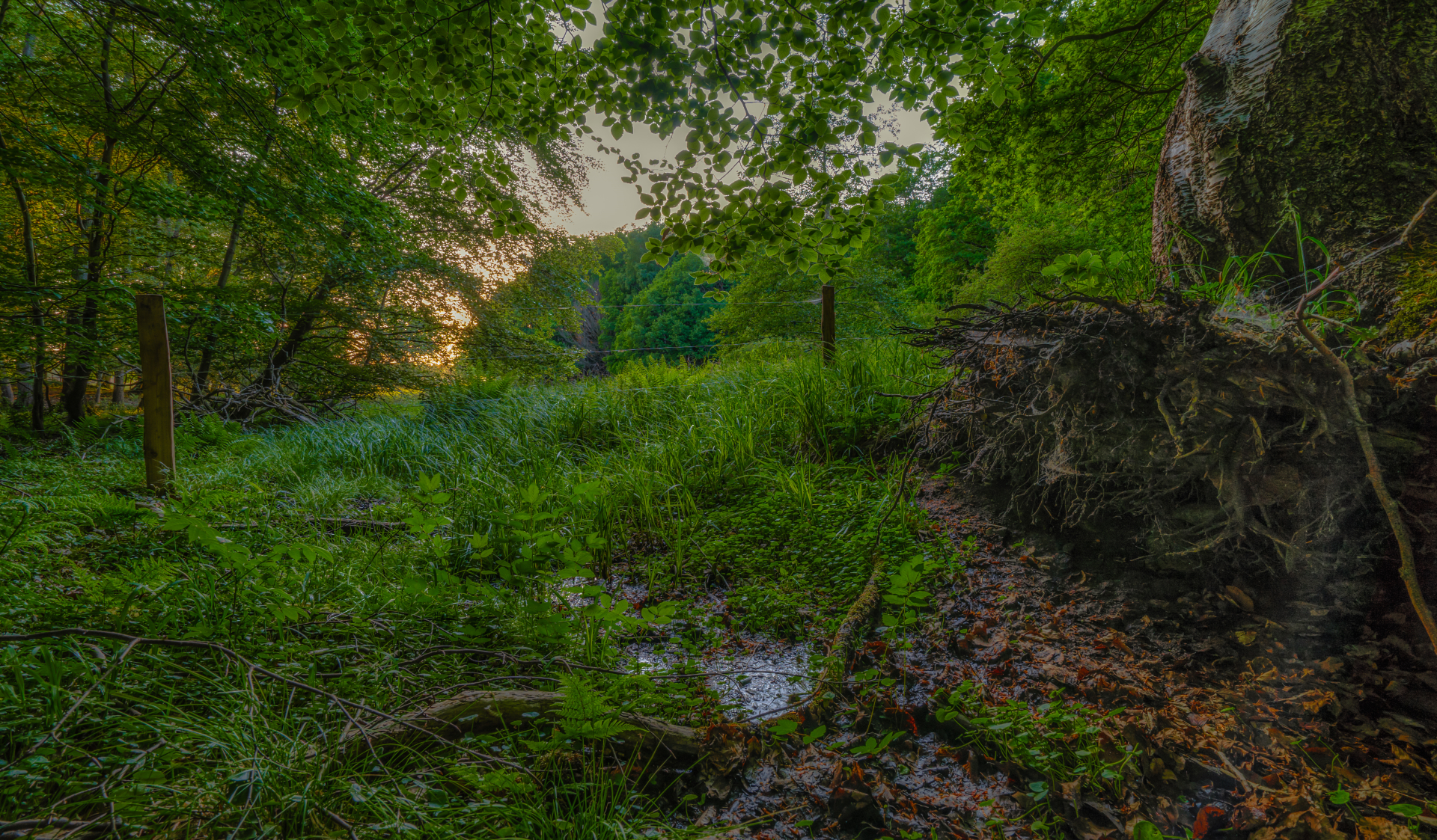 Along the way I had suddenly heard a dog bark not very far away. The barking came closer, and in an instant I went from being an amateur photographer enjoying nature to Harrison Ford in The Fugitive. I was sure some nature police squad had spotted me and was trying to hunt me down for trespassing. I hid behind a tree and cursed myself for having left my bicycle out in the open.
Along the way I had suddenly heard a dog bark not very far away. The barking came closer, and in an instant I went from being an amateur photographer enjoying nature to Harrison Ford in The Fugitive. I was sure some nature police squad had spotted me and was trying to hunt me down for trespassing. I hid behind a tree and cursed myself for having left my bicycle out in the open.
In the end, the dog moved further away, and it had probably just been out for an evening walk with its human. Still, I sighed a breath of relief and went on my way.
By now it was starting to grow dark, but just as I was considering packing up and heading back home, I saw movement through the trees ahead of me. I walked closer and approached the edge of the forest, and that's when I realized what was going on. It was the resident cow herd that was frolicking in the cool evening air. In other words, picture opportunity!
I snuck closer to the herd, which of course, they immediately spotted, un-stealthy as I am. So instead of posing for me, the cows took off, not walking lazily away, but at a gallop, and positioned themselves on a nearby ridge. They were staring at me, and I was staring back, and lo and behold, the leader cow started to move back down the hill towards me. At this point it should be mentioned that there was a fence between me and the herd. Still, I started to get a little apprehensive, because it didn't look like a very solid fence. Soon the entire herd was moving back towards me, and the leader cow did not look particularly friendly. Now, I have not heard of killer cows in Denmark, but the whole situation was starting to seem a little dicey.
Still, I kept snapping away and kept my head cool enough to increase the ISO and keep the the exposure at a decent 1/50 seconds, and here's the result of my efforts: possibly the best cow picture in my collection. Now, my wife always tells me to be careful whenever I head out on a photo mission, and I always say I will be, so I figured now was the time to live up to my word and begin my retreat in good order. So I shouldered my tripod and left the cows behind. Being cows, they probably never intended to attack me, but were merely curious and hoping for a bite to eat other than their usual grass. That wasn't going to happen as it was now time to pack up my gear and head home...
Now, my wife always tells me to be careful whenever I head out on a photo mission, and I always say I will be, so I figured now was the time to live up to my word and begin my retreat in good order. So I shouldered my tripod and left the cows behind. Being cows, they probably never intended to attack me, but were merely curious and hoping for a bite to eat other than their usual grass. That wasn't going to happen as it was now time to pack up my gear and head home...
Pack up my gear.... Where was my camera bag? Where was my camera bag?
WHERE WAS MY CAMERA BAG?????
As soon as the realization hit me that I did not have my camera bag with me, a panic started to spread through my body. Where did I last see it? I had no idea. Hopefully, I had just left it with my bicycle back on the path. I stumbled back through the underbrush, getting several nettle stings along the way. And no, there was no sign of my bag anywhere near my bicycle.
There was no way around it. I had to backtrack to all the locations I had been at, which by this time amounted to half a dozen, several of which I wasn't even sure if I could find again, having walked through semi-dense forest to get to them.
As I pedaled back to the previous spot, and the one before that, thoughts of losing a bag containing maybe $2000 worth of camera equipment was very present in my mind... or having to come back early the next morning to continue the search... or worse, having to contact the nature enclosure administration and confess my sin of having entered the area without permission, but "pretty please, would you return my camera bag if you find it, thank you..."
That's when I suddenly remembered when I had last seen it. At one of my last stops, I had changed lenses. That's where I must have left the bag on the ground. And sure enough, I managed to make it back to the spot and found the bag exactly where I left it.
My legs burning from nettle stings and bloody scratches up and down my calves from scrambling through the brush, but relieved as hell, I was finally ready to head for the exit.
But my trouble had only just started. I wanted to leave the area through the southern edge. I had done that without problem during an earlier visit, because I had found a spot where two fences didn't quite overlap and thereby left a hole big enough for a person to walk through. After finding the spot, which in itself was a challenge since no paths led to it, I realized that the missing overlap was no more.
I had to climb over the fence - with my bicycle.
The bicycle was the easy part. The fence was no taller than I was able to lift the it across. Getting my own 94 kilos to the other side was harder. There was nothing to really step on to get a good take-off, plus the fence was actually a little bit electric. I had visions of myself missing my leap and getting stuck straddling the fence and having my finer parts fried.
But it had to be done. I put my foot on the bottom string of the fence and leaped. The string broke and for a fraction of a second my worst fear was coming true. But through sheer adrenalin and will power I exerted my last strength and landed safely on the other side.
Almost overcome with exhaustion, I pulled my bicycle through the last shrubbery, tearing my shirt and adding a few more scratches to my legs. But I was out... I was finally out. I had been hunted by dogs, attacked by killer cows, had my legs shredded by thorns and nettles, almost lost most of my camera equipment, and been forced to cross an electric fence, but I was alive. And I had a memory card full of what I hoped was a bunch of outstanding images.
Back on the bicycle path, I found that the chain had fallen off my bike. I didn't care. I put it back on and headed home.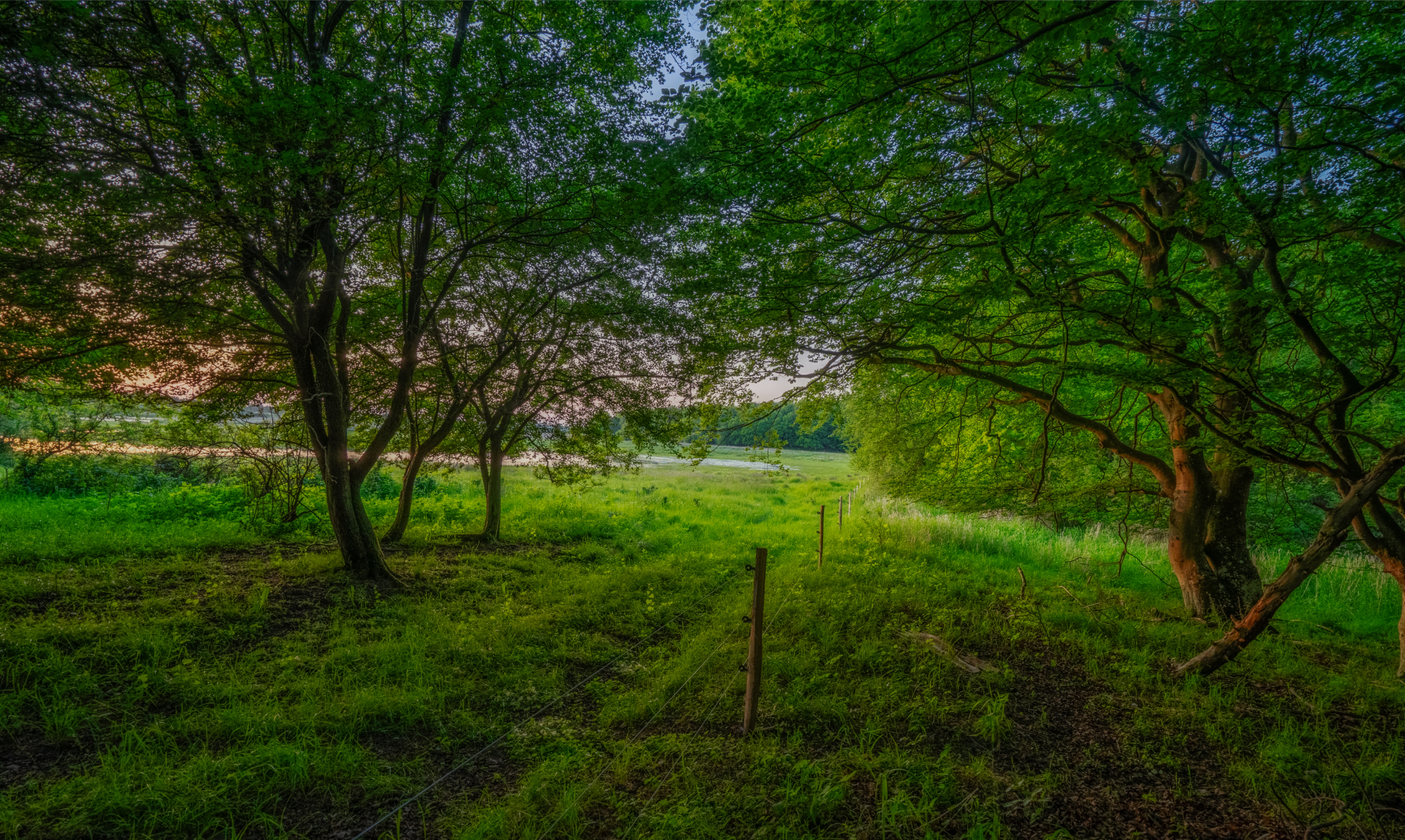
So, a couple of days ago I went out on a run in the local forest. And now you're no doubt getting all kinds of images in your head of one of those uber-cool middle-aged men in Lycra clothes training for the next marathon or triathlons in some far-away metropolis. And sure, on my good days that's kind of how I view myself, too, despite needing 17-18 minutes to cover my measly 3 kilometer route.
On this day I wasn't feeling particularly gazelle-like, but I wasn't feeling horrible either. After approaching the 1 kilometer mark, I still felt like this could indeed be the day when, for the first time this season, I completed my 3 kilometers without having to walk for a bit in the middle.
However, I was never to find out. Suddenly my foot hit an obstacle, and for a terrifying second I found myself desperately trying to regain my balance but failing miserably and stumbling forwards, cell phone flying out of my hand, left knee hitting something hard on its way down, and my almost 49-year-old, overweight body hitting the forest path with all of its 94 kilos, probably registering as a pretty major event on local ant community seismographs, if such a thing exists.
With the adrenalin racing through my blood, I didn't spend much time spread out on the ground, intending instead to continue running as if nothing had happened. But getting up and looking down on myself I had to face the fact that my cool Lycra running pants had been torn open around my left knee and blood was visible. So I figured I'd better take it easy for a little while as I assessed my injuries.
I picked up my trusty Samsung, stopped my Endomondo session, which had happily continued counting the seconds of my ill-fated exercise, and started walking. And that's when it happened. I looked up and found myself in the middle of one of nature's miracles. All around me lush, light-green leaves were seemingly free-floating in the air, frail and tender, and so fresh they looked like they might not have been there five minutes ago.
I suddenly realized that if some invisible bump in the path hadn't forcefully stopped me, I might have missed the full extent of this wonder. I raised my, fortunately unscathed cell phone, and started shooting, forgetting all about my aching knee and hurt pride. The sun was shining from a clear blue sky, emphasizing the incredible greenness of these leaves. I have never covered spring at a more perfect moment. In a week or two the forest will be completely green and absolutely mindblowingly beautiful, and I will no doubt be out there shooting it with my Sony, but to catch it at this exact time and in this light felt like a stroke of luck that more than compensated for my misery.
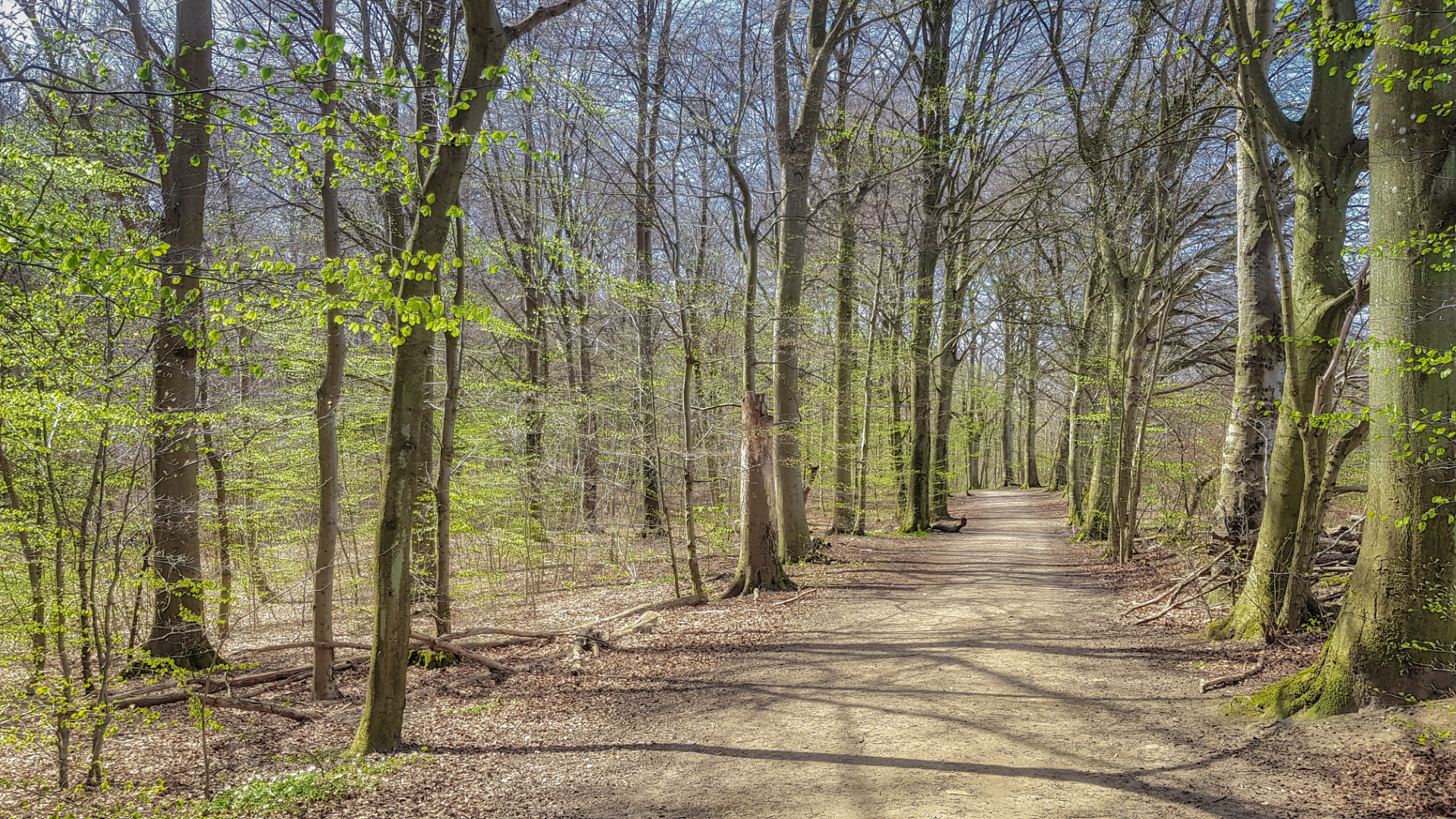
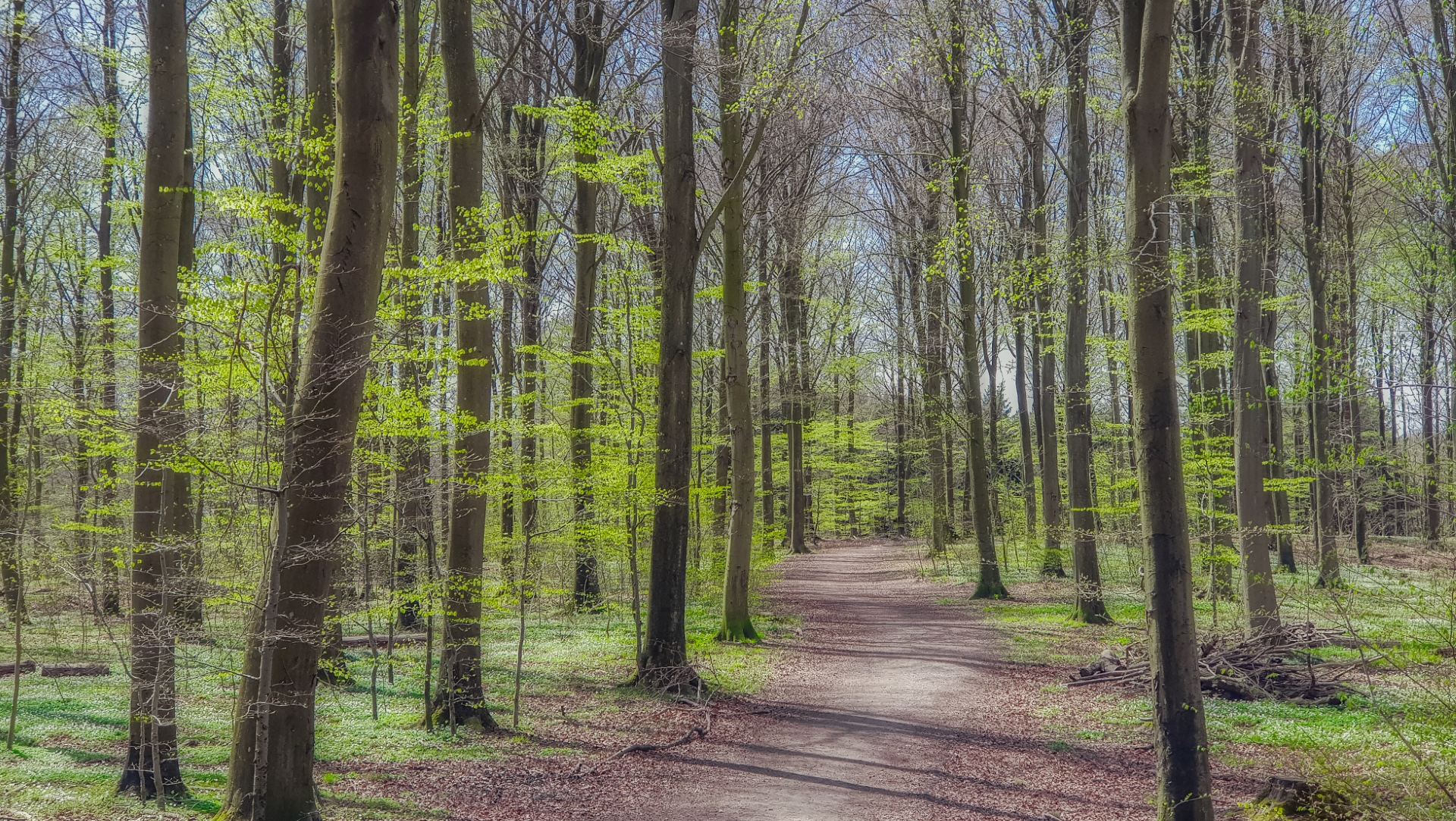
 I half ran, half walked the rest of the way home. There I soon realized that my fall had been worse than first estimated. The wound in my knee was big and painful, and my body was aching in several places - and still does as I'm writing this. But looking at these images and reliving the awe I was feeling in the moment, I can only smile.
I half ran, half walked the rest of the way home. There I soon realized that my fall had been worse than first estimated. The wound in my knee was big and painful, and my body was aching in several places - and still does as I'm writing this. But looking at these images and reliving the awe I was feeling in the moment, I can only smile.
I may not be the greatest photographer in the world, but I'm a hell of a lot better at taking pictures than I am at running, and that's all right with me.
They say that once every few thousand years, the magnetic poles flip, reversing north and south. What the scientists missed was that the flip took place last weekend, and for a brief period during the shift, positioned the North Pole in Odsherred, Denmark.
As it happened, Odsherred was the part of Denmark where, that very weekend, my wife and I had decided to spend a couple of days away from the humdrum of our every day life and see something new. We ordered the trip a while back thinking the middle of March would be, if not full-blown spring, then at least noticeable more pleasant than the cold winter.
How wrong we were. Even on our way over there during a stop at a small marina, we got a preview of what was to come. The marina was protected from the wind by a tall ridge, but plenty of cold air coming straight out of Siberia reached us to make us shiver and start worrying a bit about what we'd gotten ourselves into.
Still, I managed to get off a few shots of the beach area, in pretty difficult middle-of-the-day-light, including this nice one showing cloud reflections in the reasonably calm water.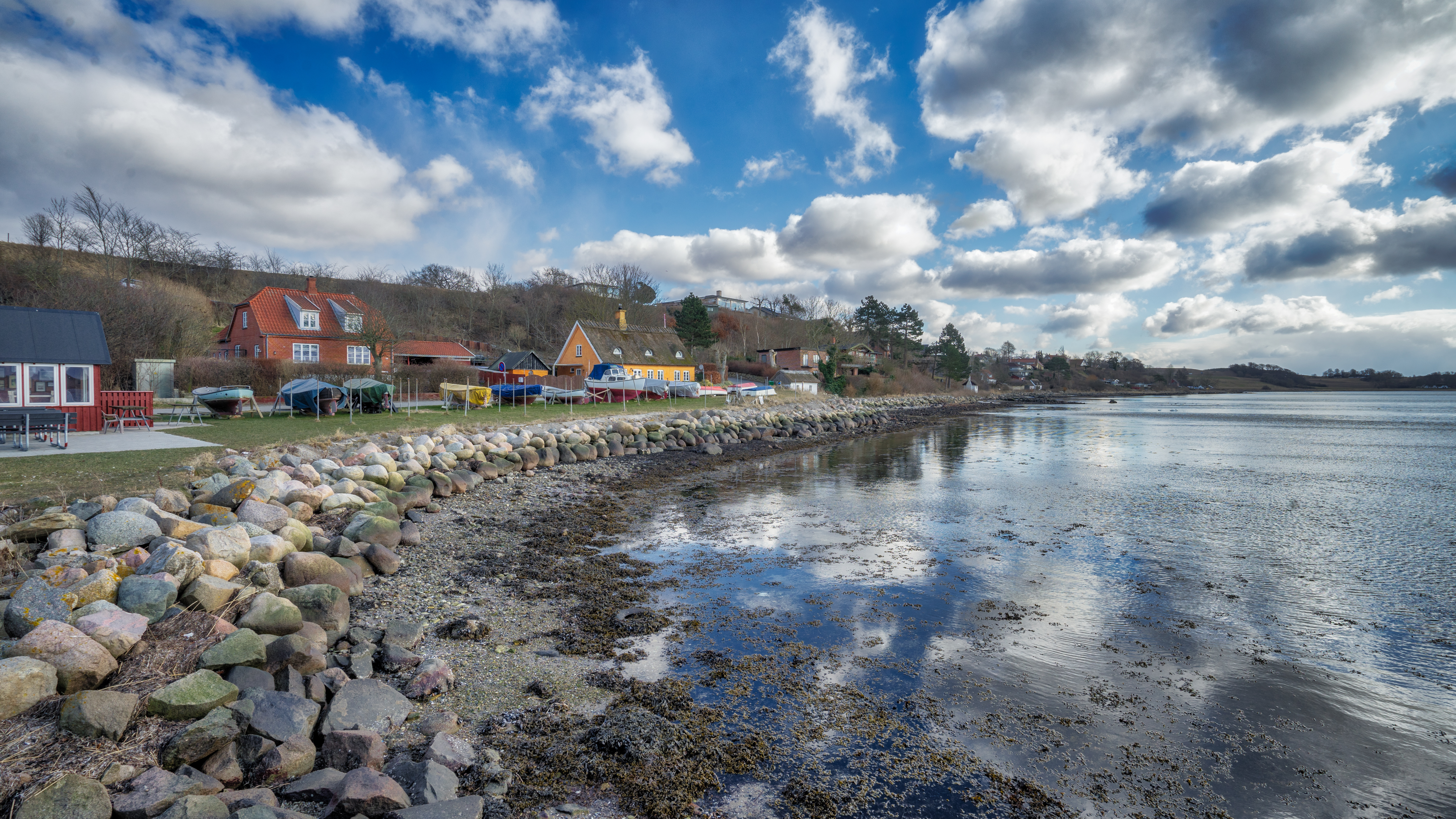 That same evening after checking in to our hotel, we went for a walk in the area near the hotel. The sun was low in the sky and revealed some beautiful scenery with a peaceful lake surrounded by animal pastures. There were no animals, however, as they - or their owners - had realized what perhaps we should have realized ourselves: it was too damn cold to be outside. The photography suffered as a result. There wasn't time for much location scouting, so I wasn't quite happy with the images of what, at first glance, had looked like a slam dunk. This one is pretty nice though, but nothing spectacular.
That same evening after checking in to our hotel, we went for a walk in the area near the hotel. The sun was low in the sky and revealed some beautiful scenery with a peaceful lake surrounded by animal pastures. There were no animals, however, as they - or their owners - had realized what perhaps we should have realized ourselves: it was too damn cold to be outside. The photography suffered as a result. There wasn't time for much location scouting, so I wasn't quite happy with the images of what, at first glance, had looked like a slam dunk. This one is pretty nice though, but nothing spectacular.
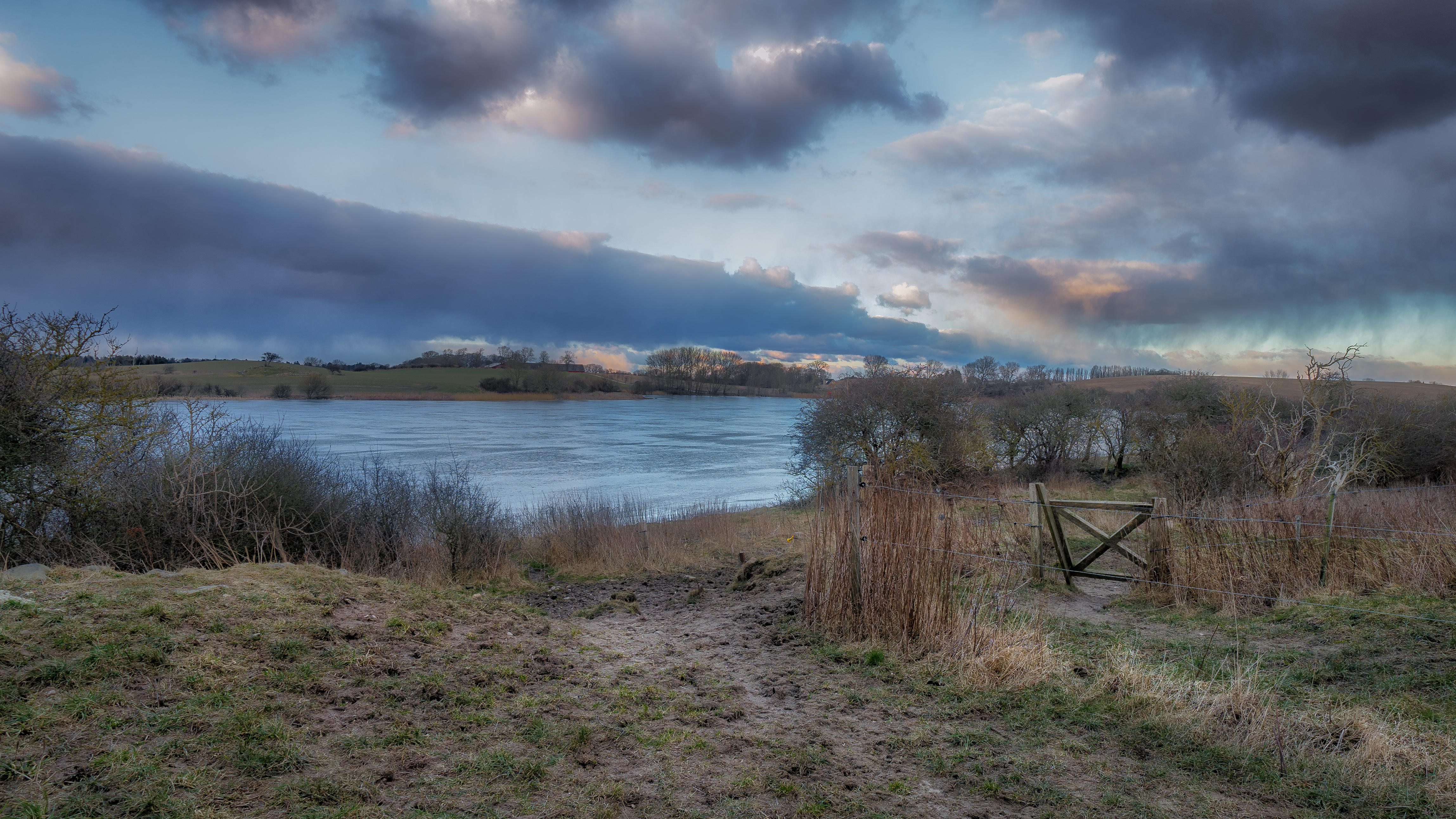 The next day was our only full day in Odsherred. There were several locations I wanted to seek out, most importantly the long strip of land that protrudes from the north-west corner of Zealand and ends in the middle of the ocean. About halfway to the tip, we spotted a parking lot at a beach and decided to get out and take a look.
The next day was our only full day in Odsherred. There were several locations I wanted to seek out, most importantly the long strip of land that protrudes from the north-west corner of Zealand and ends in the middle of the ocean. About halfway to the tip, we spotted a parking lot at a beach and decided to get out and take a look.
That's when it happened. Stepping out of the car and down to the beach, the realization that today wasn't just cold cold - today was excruciatingly cold, as in dangerously cold, as in physically painful cold - hit.
It was the wind. It came in from the north-east. 20-30 kilometers an hour, multiplying the -5 degrees Celsius by 4-5 times. It cut through my knitted hat like a knife and into my skull, instantly setting off a brutal headache. But still I persisted. The scenery was too spectacular to miss. Wave after wave came rolling in, crashing against rocks loosely spread along the beach, white clouds drifting across the blue sky. I ran back and forth, shooting one image after another, the freezing wind mutilating my face and hands like an ice-shooting blowtorch.
It paid off. The best image of the entire weekend was shot here on this North Pole beach. Several others were almost as good.
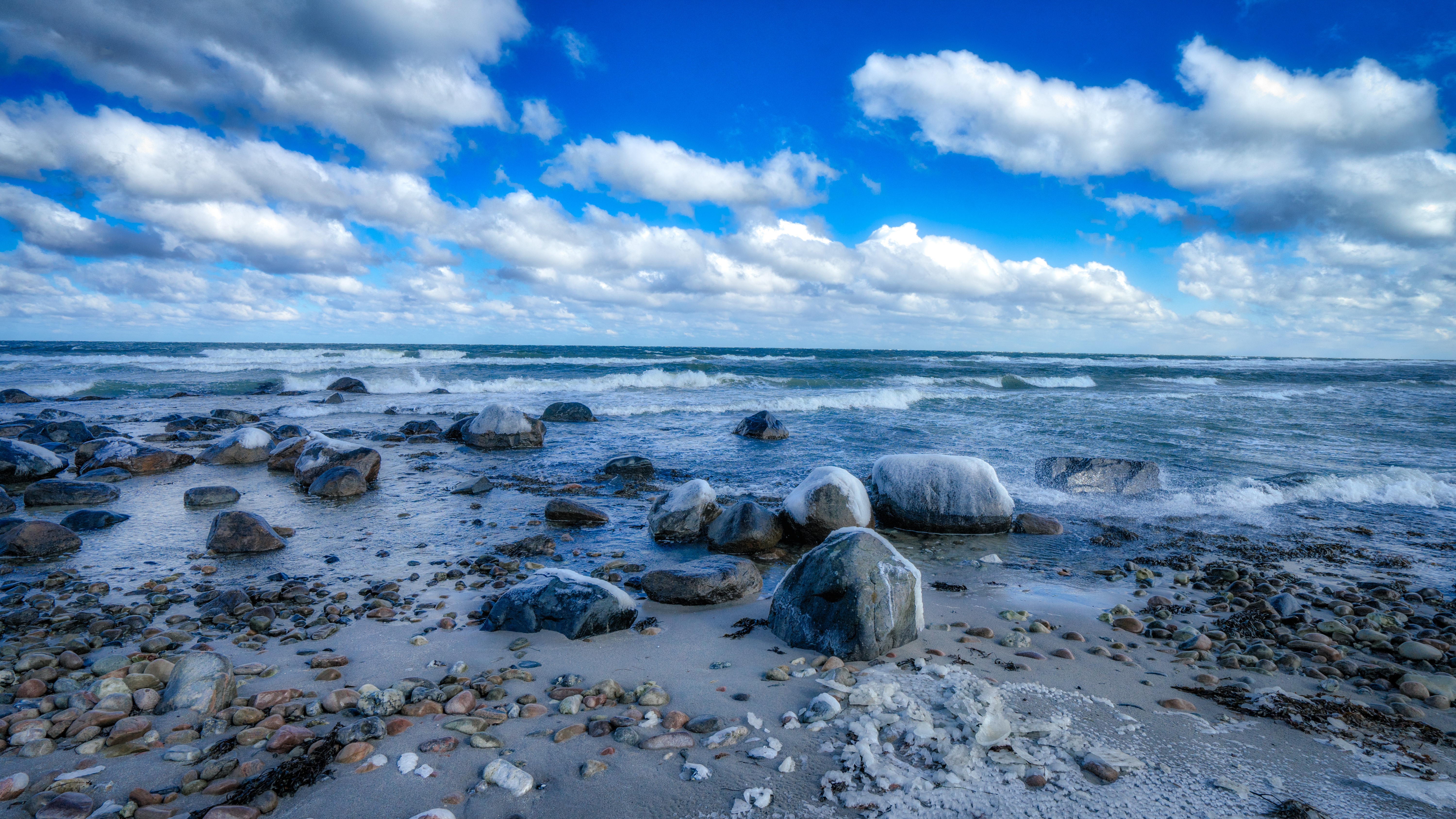 Moving on to the actual tip of the land tongue, we found ourselves on another beach every bit as brutal as the one we had just left. By this time I had somehow managed to zone in to my usual viking mode where cold doesn't affect me much. I could still feel the pain of icy wind on my exposed skin, but this time it didn't take away my focus or my ability to operate the camera. The result was another batch of images that I'm rather proud of, including these two... and the selfie that you see at the top of this post.
Moving on to the actual tip of the land tongue, we found ourselves on another beach every bit as brutal as the one we had just left. By this time I had somehow managed to zone in to my usual viking mode where cold doesn't affect me much. I could still feel the pain of icy wind on my exposed skin, but this time it didn't take away my focus or my ability to operate the camera. The result was another batch of images that I'm rather proud of, including these two... and the selfie that you see at the top of this post.
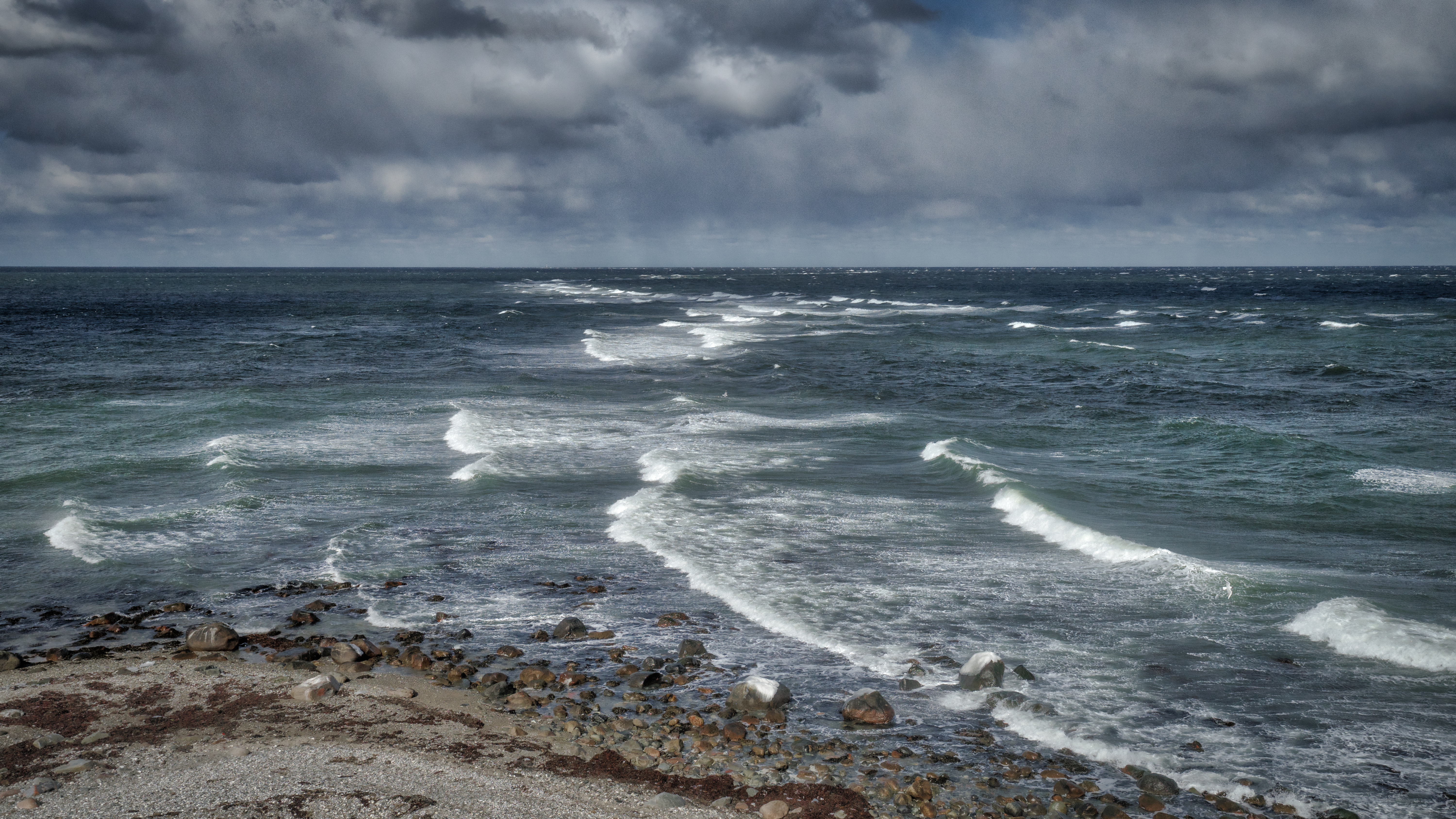
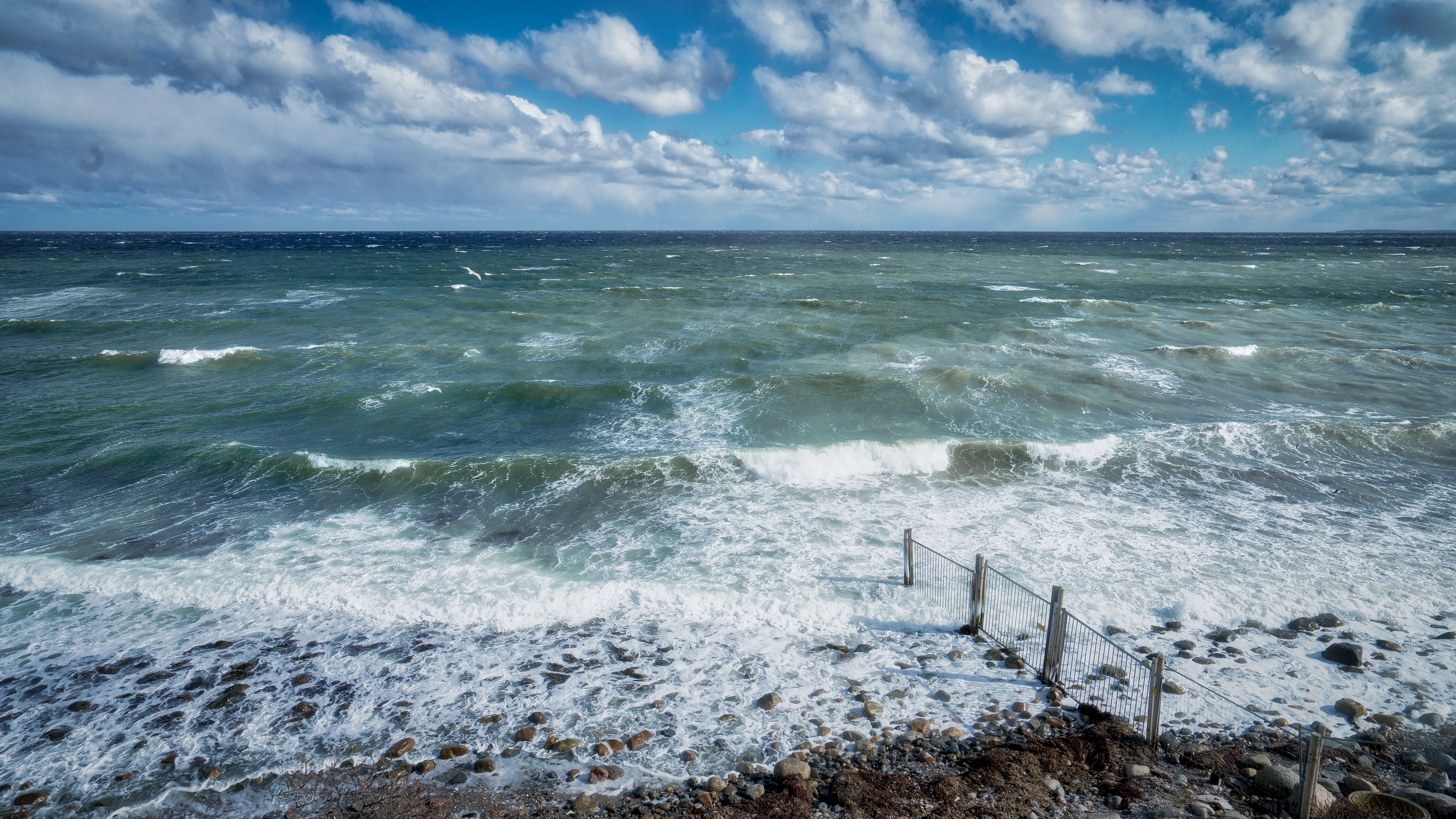 Our next stop was the small ferry town of Rørvig (don't even try to pronounce it if you are not Danish). We were met by another freezing sledgehammer, but the light was spectacular. Out over the sea, snow showers lingered while the sun set fire to the water. I snapped away and caught these decent images along with several others I was happy with.
Our next stop was the small ferry town of Rørvig (don't even try to pronounce it if you are not Danish). We were met by another freezing sledgehammer, but the light was spectacular. Out over the sea, snow showers lingered while the sun set fire to the water. I snapped away and caught these decent images along with several others I was happy with.
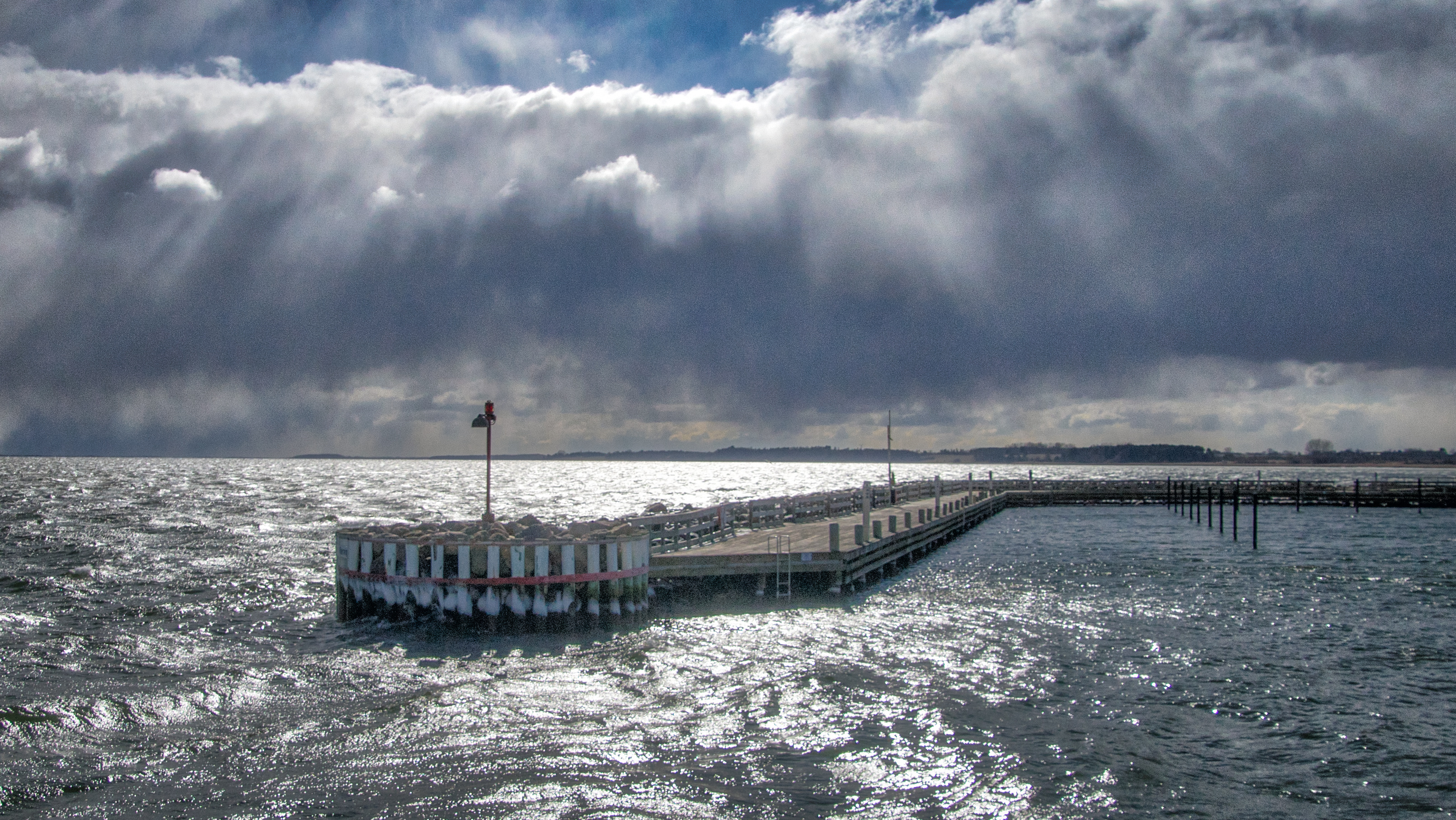
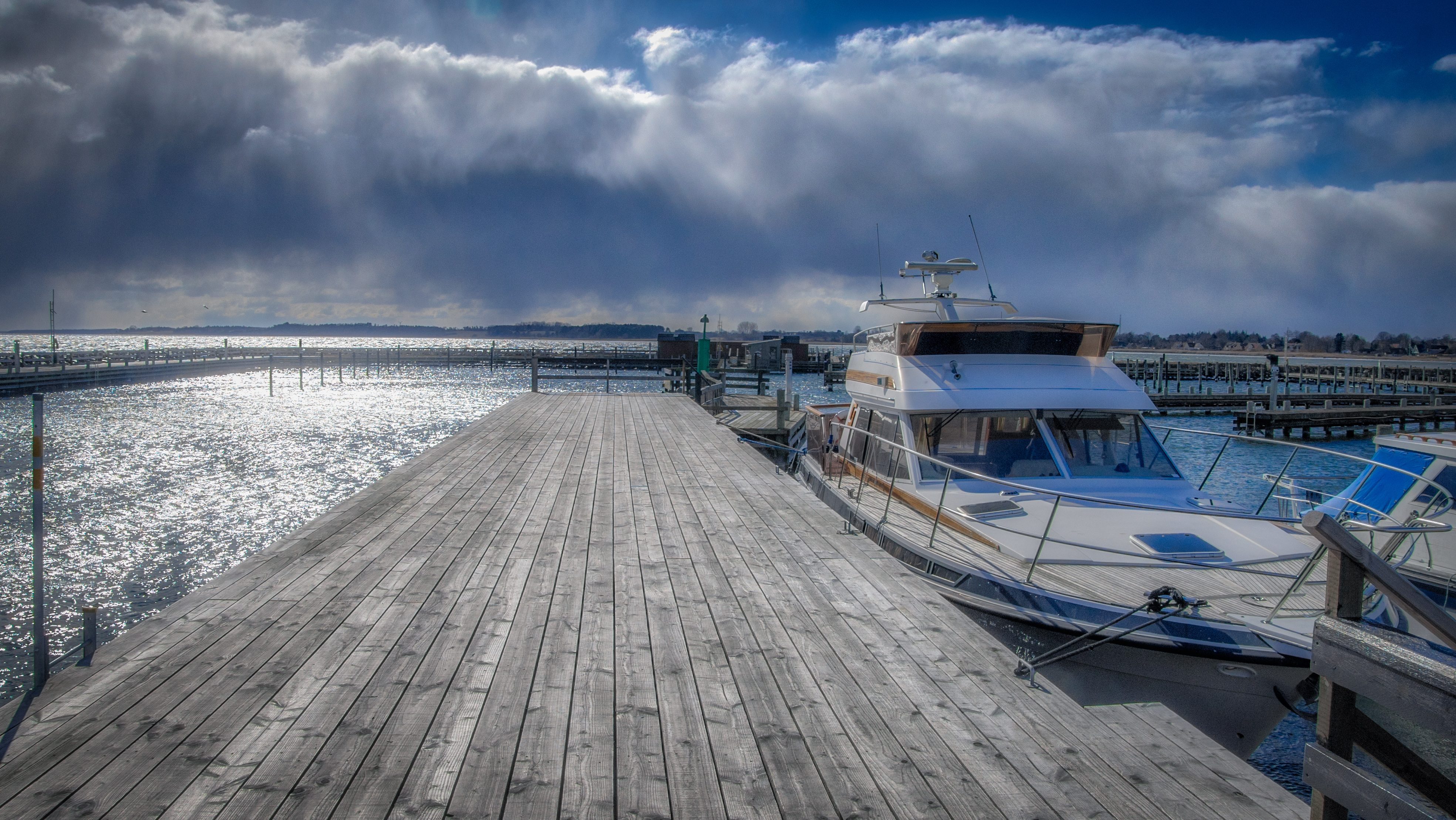 Our last stop of the day was at the old castle ruin of Næsholm, "ruin" being the keyword. There is practically nothing left of whatever it once was, but it was still more than worth a visit. It's located on a small island in the middle of a lake. A boardwalk bridge leads out to it, and once you are there, you are in your own tiny, little world, at peace with yourself and nature. At least, that's how I felt. Birds were everywhere, the wind was rustling in the tall grass, and there was no discernible human activity within hearing distance.
Our last stop of the day was at the old castle ruin of Næsholm, "ruin" being the keyword. There is practically nothing left of whatever it once was, but it was still more than worth a visit. It's located on a small island in the middle of a lake. A boardwalk bridge leads out to it, and once you are there, you are in your own tiny, little world, at peace with yourself and nature. At least, that's how I felt. Birds were everywhere, the wind was rustling in the tall grass, and there was no discernible human activity within hearing distance.
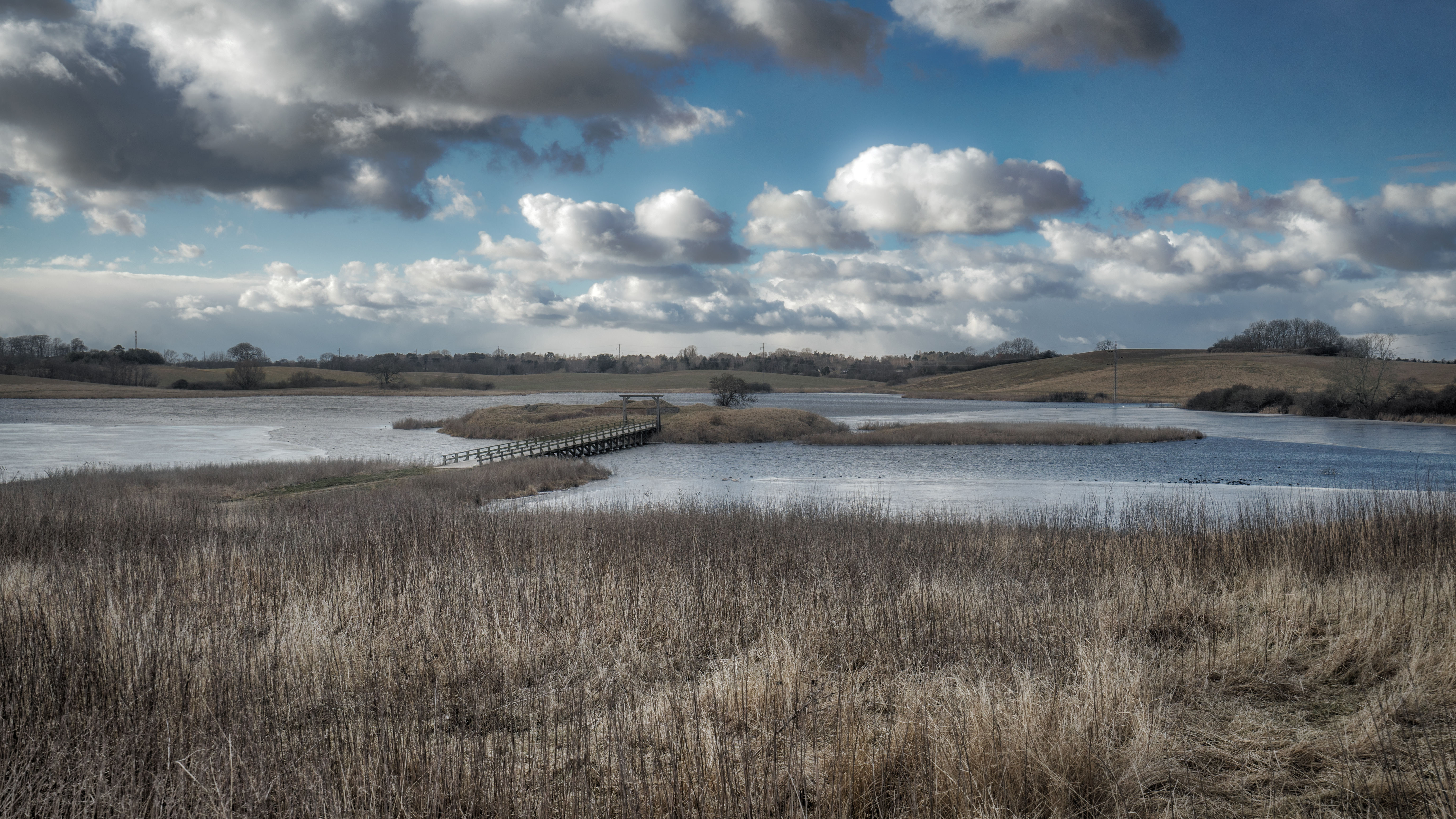 As far as the ruin is concerned, the image below pretty much shows it all.
As far as the ruin is concerned, the image below pretty much shows it all.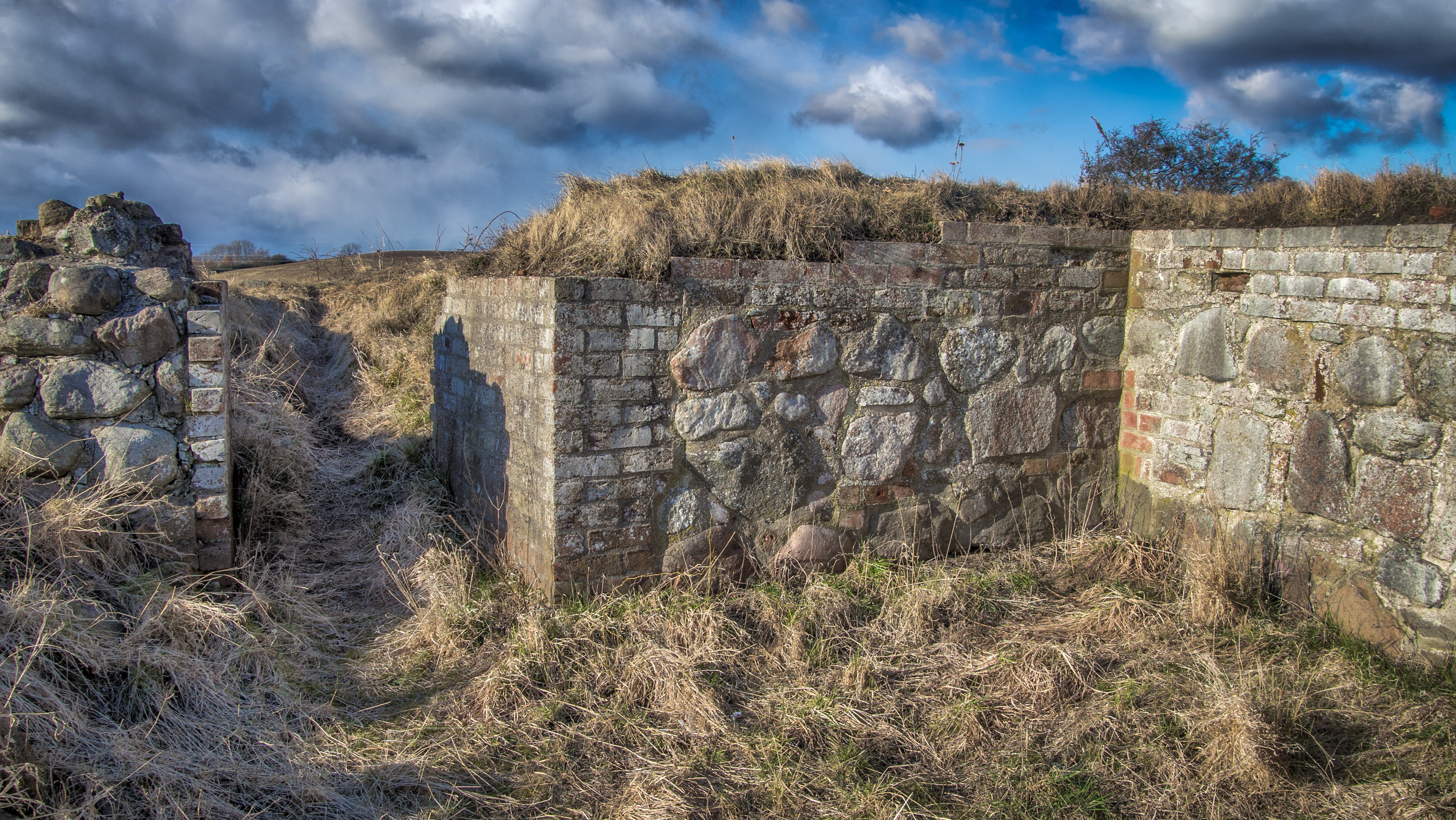 The water surrounding the lake was halfway covered with ice, making for another interesting photographic subject.
The water surrounding the lake was halfway covered with ice, making for another interesting photographic subject.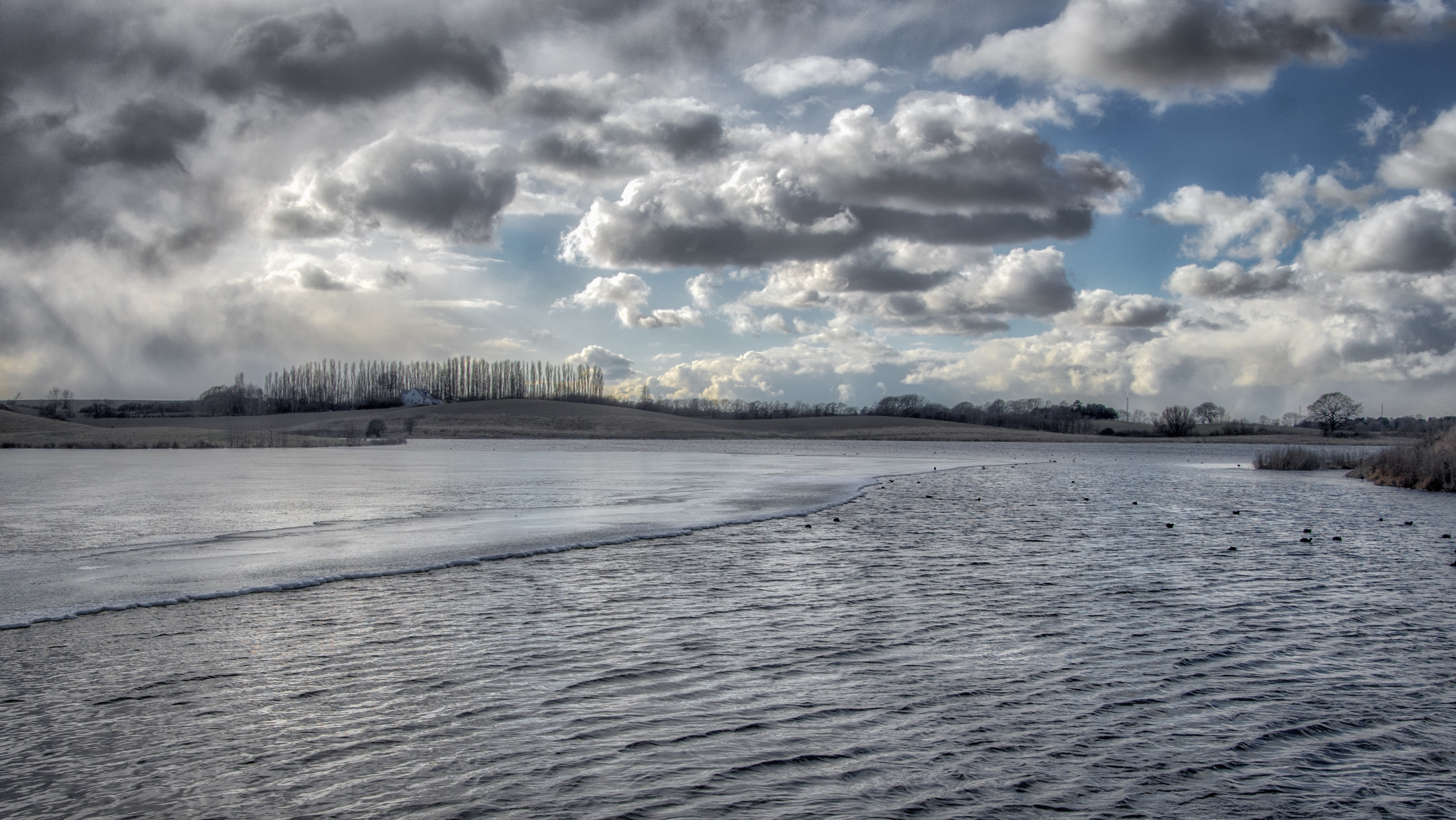 After spending way too much time at Næsholm, we headed back to the hotel for some much needed warmth. It had been a busy day with lots of stops, but there were still a few places left to see. So the next - and last - day we headed out to climb some of the famous peaks of the Danish landscape. Our first stop - Esterhøj - is a whopping 89 meters above sea level (almost 300 feet!), but that didn't stop us. We donned our ropes and helmets and walked up the stairs to the top.
After spending way too much time at Næsholm, we headed back to the hotel for some much needed warmth. It had been a busy day with lots of stops, but there were still a few places left to see. So the next - and last - day we headed out to climb some of the famous peaks of the Danish landscape. Our first stop - Esterhøj - is a whopping 89 meters above sea level (almost 300 feet!), but that didn't stop us. We donned our ropes and helmets and walked up the stairs to the top.
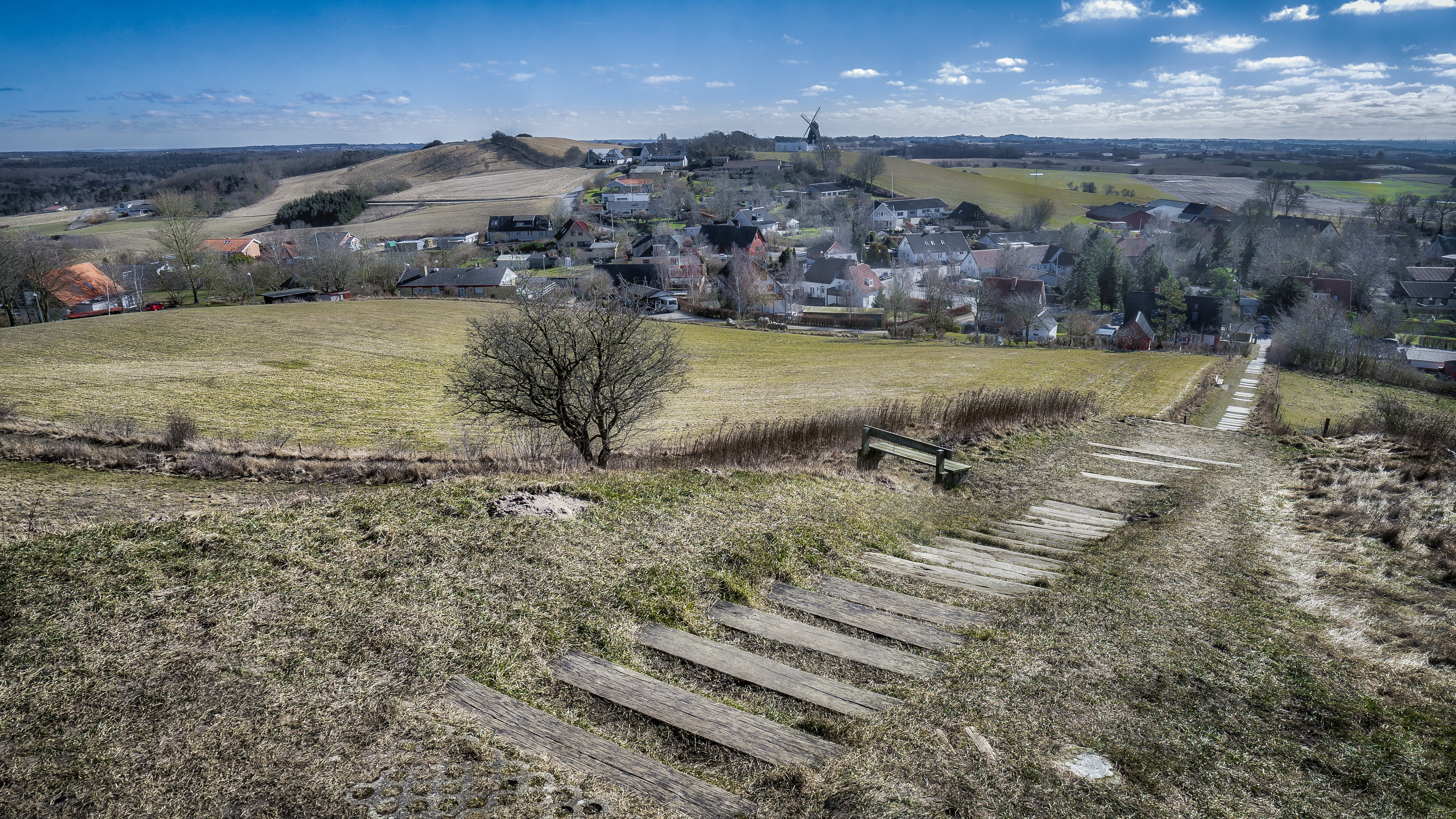 The view was actually quite awesome. It was a clear day, and you could see for miles in all directions. The problem, photography-wise, was the harsh middle-of-the-day light and the fact that big, rather featureless landscapes don't make for great images. There are no majestic mountains to serve as a backdrop. On this day there weren't even some dramatic clouds to spice things up.
The view was actually quite awesome. It was a clear day, and you could see for miles in all directions. The problem, photography-wise, was the harsh middle-of-the-day light and the fact that big, rather featureless landscapes don't make for great images. There are no majestic mountains to serve as a backdrop. On this day there weren't even some dramatic clouds to spice things up.
So what I did was to listen to the miniature Thomas Heaton I've got sitting on my shoulder and look for the small, interesting details in the landscape. I put on my 18-270 mm Tamron lens, zoomed it all the way in and scanned the landscape for compositions. And came up with this:
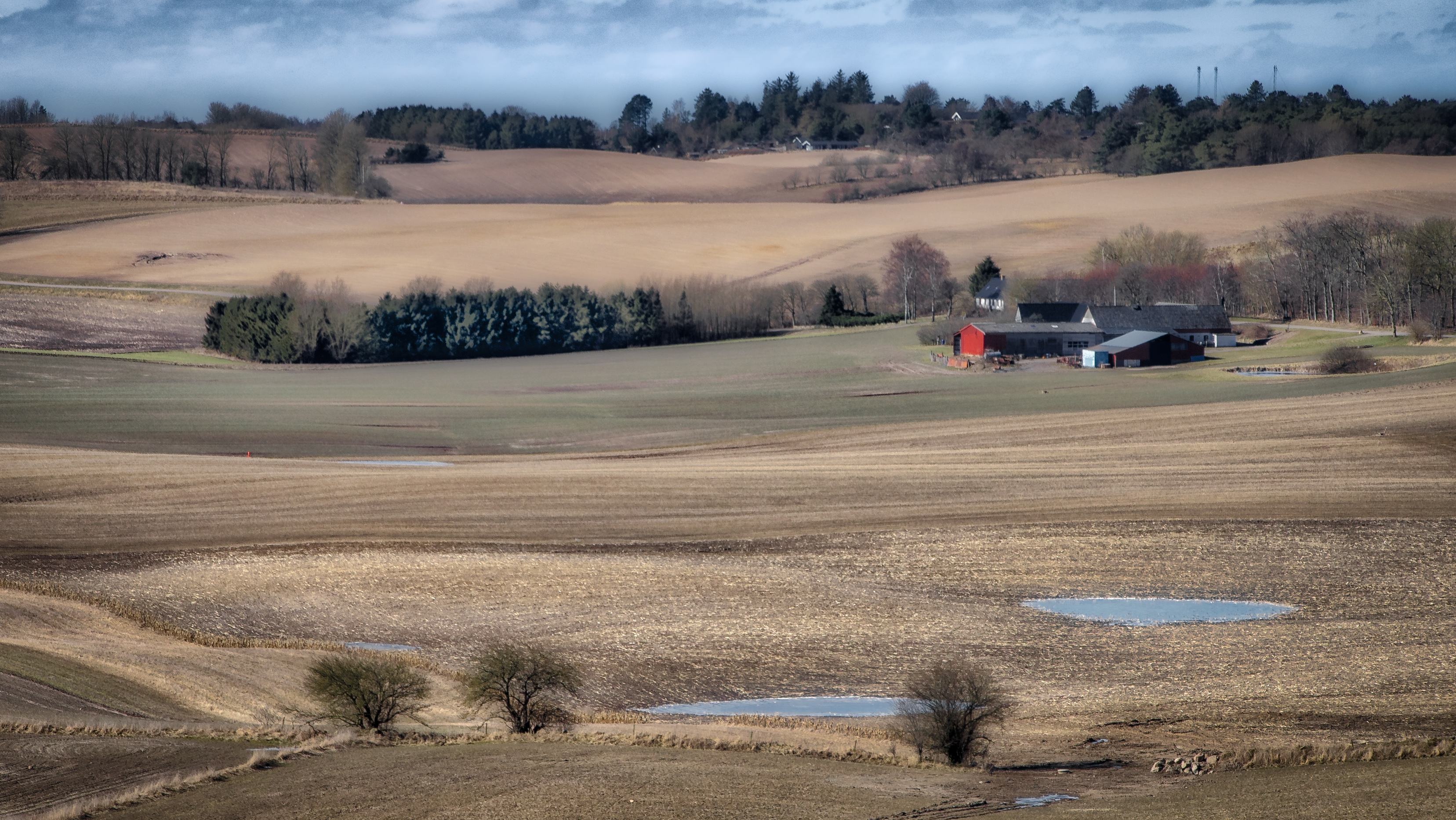 I'm actually quite pleased with it. The lens is not the sharpest in my collection, but what the image doesn't have in sharpness, it makes up for in zen-ness.... or something.
I'm actually quite pleased with it. The lens is not the sharpest in my collection, but what the image doesn't have in sharpness, it makes up for in zen-ness.... or something.
I used the same procedure for the next image, which was taken from the top of another famous hilltop, Vejrhøj. Again, the sharpness leaves a lot to be desired, but there was something about the shape of the coastline that intrigued me. And look at those white waves. They were actually moving offshore in the strong eastern wind.
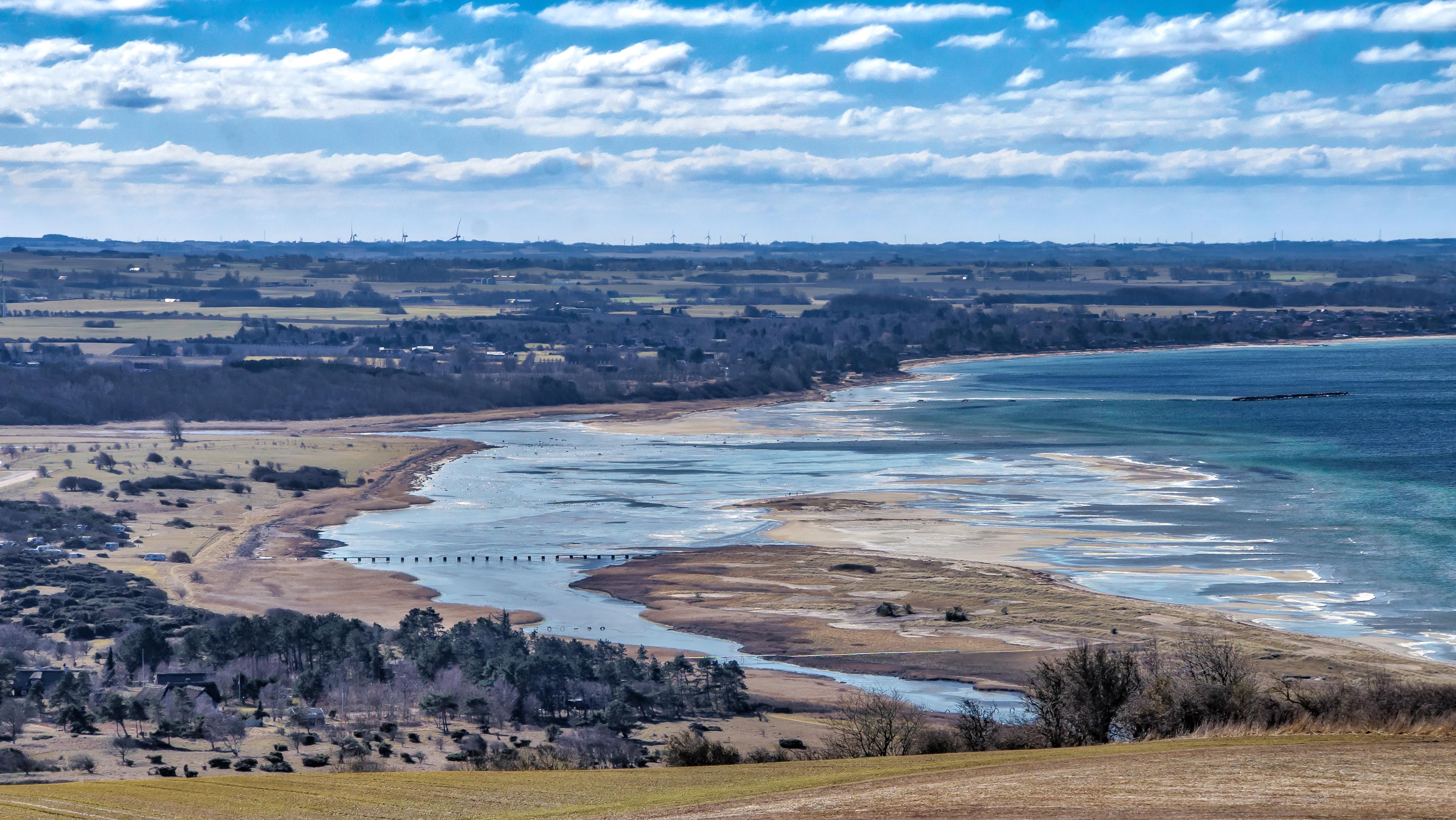 The last image was taken walking off down from Vejrhøj through a patch of woods. As described in my last post, taking good pictures of a dreary, gray, snow-less winter landscape is a challenge, but it's actually even harder to take pictures of a sunny, snow-less winter landscape. It's sort of neither here nor there... It's not dreary and it's not uplifting, so it easily becomes just blah... But the below image was one of the few I took in that forest that I felt pretty good about.
The last image was taken walking off down from Vejrhøj through a patch of woods. As described in my last post, taking good pictures of a dreary, gray, snow-less winter landscape is a challenge, but it's actually even harder to take pictures of a sunny, snow-less winter landscape. It's sort of neither here nor there... It's not dreary and it's not uplifting, so it easily becomes just blah... But the below image was one of the few I took in that forest that I felt pretty good about.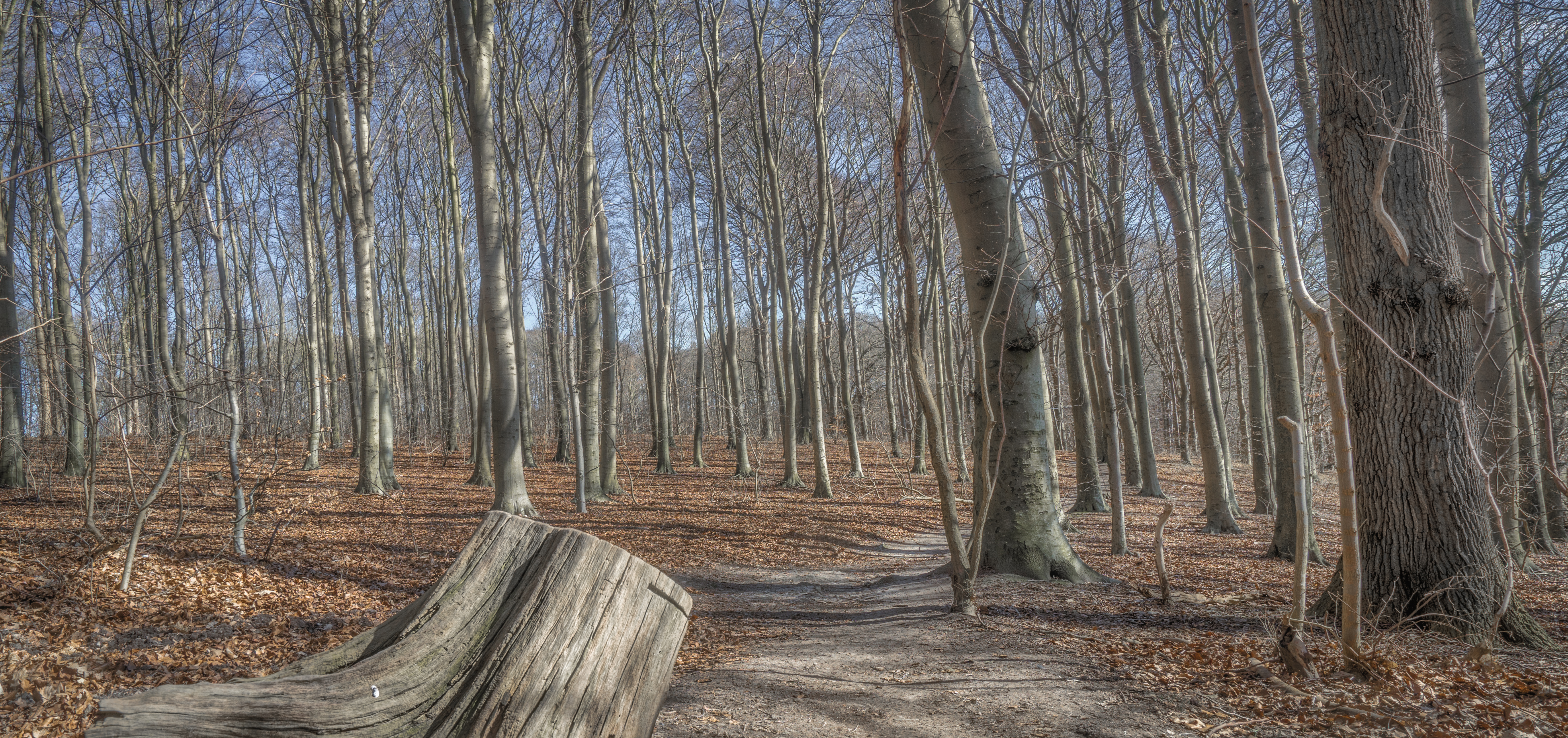 Apart from a solid lunch at a steakhouse in the town of Holbæk, thus ended our weekend adventures and, soon after, the magnetic North Pole's passage of Odsherred. As much as I enjoy just walking around my own neighborhood taking pictures of well-known locations, there is nothing like new ground far away from home to boost your motivation and skills. You don't have "tomorrow" or "tonight at sunset" to go out and improve the result. You need to get the best out of it here and now, bad light, freezing cold, and lack of time be damned.
Apart from a solid lunch at a steakhouse in the town of Holbæk, thus ended our weekend adventures and, soon after, the magnetic North Pole's passage of Odsherred. As much as I enjoy just walking around my own neighborhood taking pictures of well-known locations, there is nothing like new ground far away from home to boost your motivation and skills. You don't have "tomorrow" or "tonight at sunset" to go out and improve the result. You need to get the best out of it here and now, bad light, freezing cold, and lack of time be damned.
For all those obstacles, I think I could have done worse.